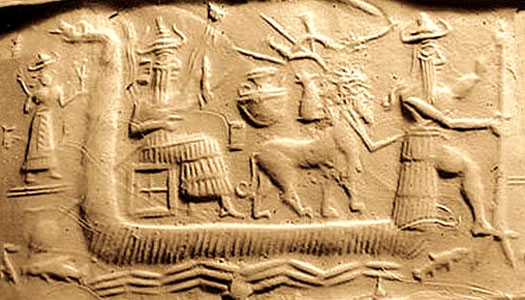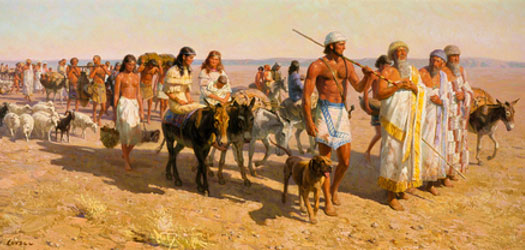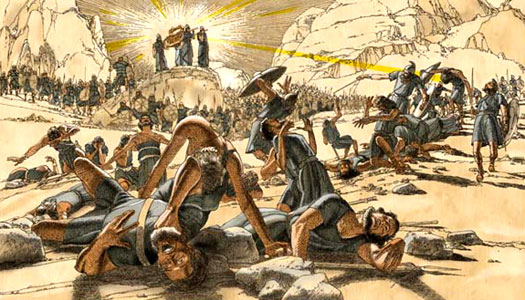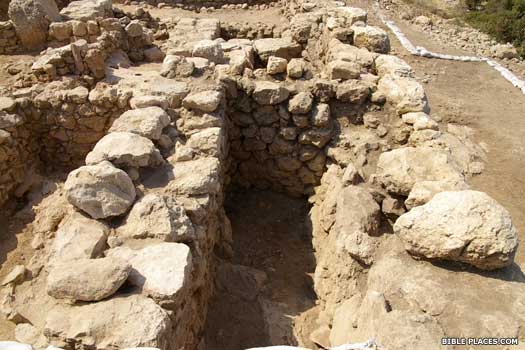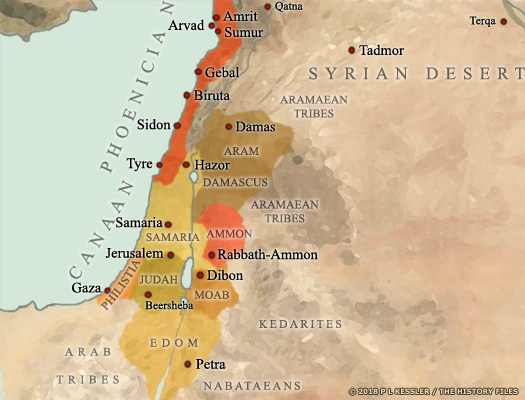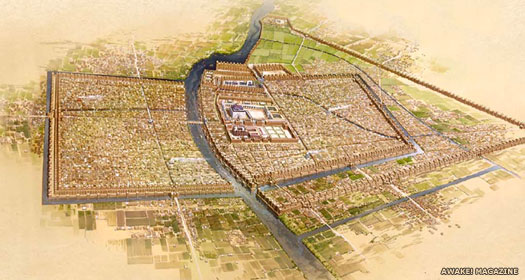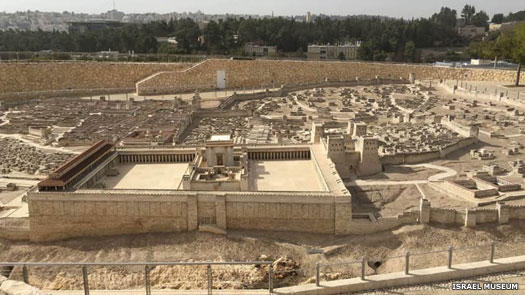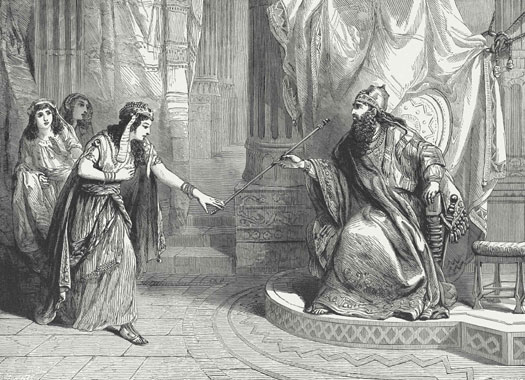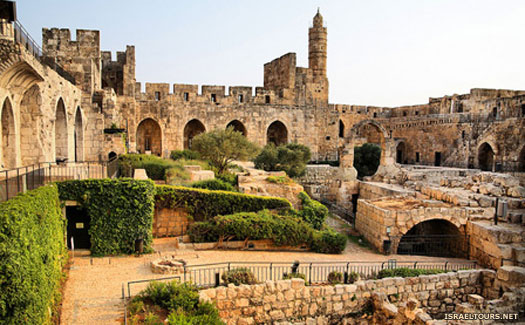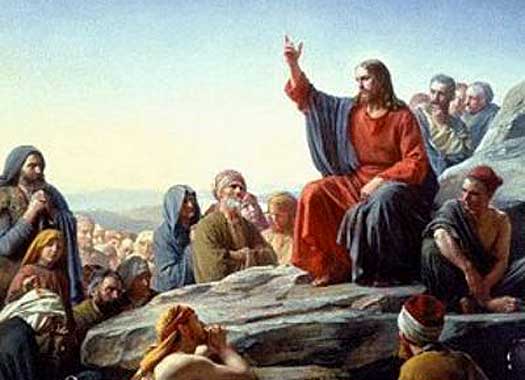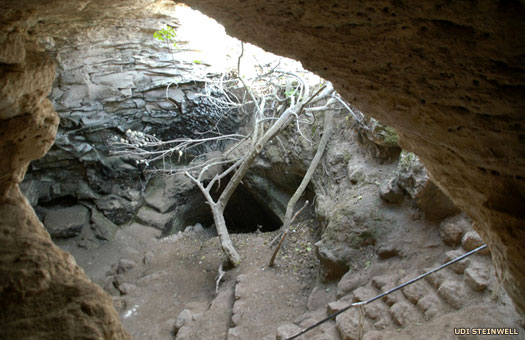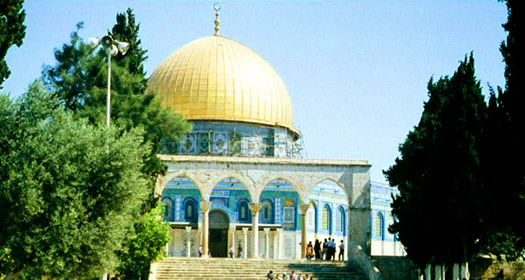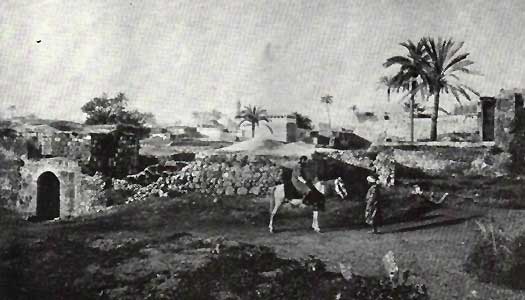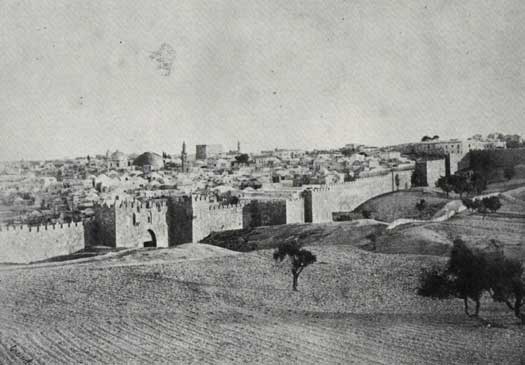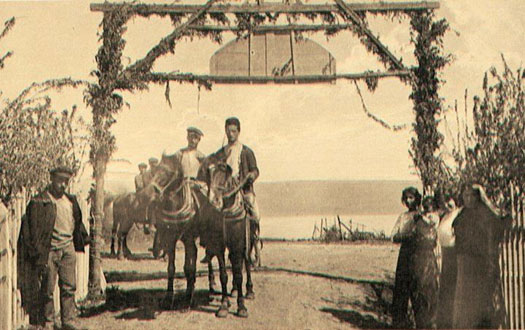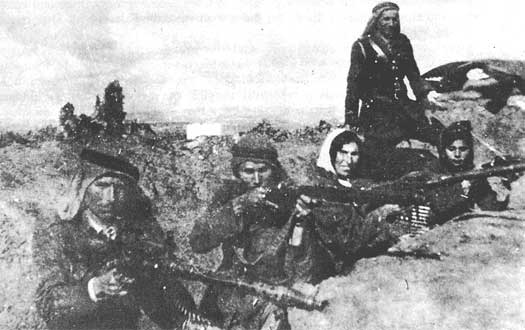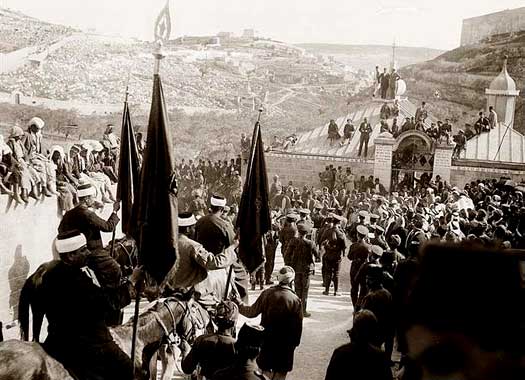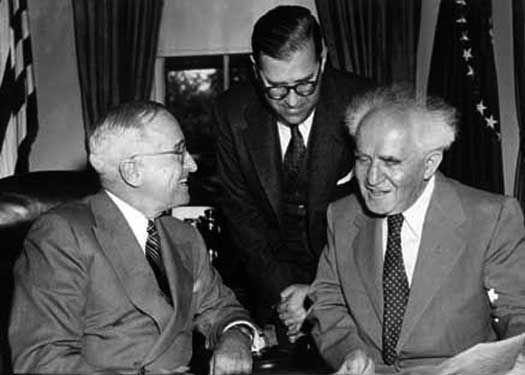
| ISRAELITE TRIBE According to tradition, the Israelites were Semitic émigrés from southern Mesopotamia who left the city of Ur during the reign of Hammurabi of Babylonian, when his empire was at its height. A confederation of tribes, they initially settled on the coast of the Dead Sea, before being forced to emigrated to Egypt, only to return centuries later to form small kingdoms in Canaan during the period of deep social unrest around and after 1200 BC.
Oral history almost always has a core truth at its heart (something that can be forgotten by scholars who wander off at tangents with imaginative theories about tribal origins). The assertion that the Israelites came from Mesopotamia has to be taken at face value. However, it doesn't necessarily have to refer to a wave of thirteen tribes and several hundred or more tribespeople wandering into Canaan. Archaeology alone has disproved this version of events. Instead, as with tribal associations everywhere in history, the arrivals probably formed a small but powerful - and possibly more technologically advanced - group that quickly became a ruling nobility over Canaanite tribes. As with other such cases, such as various tribes of the Celts and Germanics, or the Mitanni when they arrived to dominate the Hurrians, the new arrivals were in command, but their own customs were quickly replaced by those of their majority subjects, making them also look Canaanite in origin. The simplest answer is usually the best one.
In their early years the Israelites were probably more usually known as habiru (which may or may not be a source for the name 'Hebrew') when they migrated into Canaan from Mesopotamia, and also when they supposedly invaded Canaan in the twelfth century BC through Edom and Moab, penetrating as far north as Amurru in Syria. This term seems first to have been used for a range of outsiders, from unemployed farm labourers and vagrants to mounted mercenary archers. The context differed depending upon where the references were found. Although it may originally have referred to just about any marginal people who lived outside state controls, there is nothing to preclude one such group becoming the later Hebrews.
While the Bible's Old Testament is the primary source for much of the information on the second and first millennium BC Israelites, the Jewish historian, Flavius Josephus, also provides a highly interesting interpretation in Greek for his predominantly Roman audience in his massive work, Jewish Antiquities. The early parts of this list are largely made up of a combination of incidents from both sources. The dating agrees with sources such as Oxford, but others date Abraham to about 2000 BC, Joseph at about 1800 BC, Moses at about 1400 BC, and David and Solomon at 1000/900 BC. There are various chronologies which differ to some degree (the orthodox dating, or Thiele, Usher, or Rohl (an exceptionally unorthodox dating which has been greeted with near-universal disdain), Velikovsky, and Courville included). The book of Genesis provides Terah's ancestry back to Noah, many of whose members are fanciful attempts to link to ancient kingdoms and states, but the ages of the earliest figures mentioned must be taken with a pinch of salt. The names of direct descendants, though, may well be correct, part of an oral tradition which, in any culture, has always placed a strong emphasis on ensuring an unbroken list of ancestors. These names are shown below with a lilac background to highlight their near-mythical status. Spellings are various, taken from Hebrew and Greek sources mainly.
(Information by Peter Kessler, with additional information by Sean Bambrough (on Israelite dating, the figure of Joseph, and the Amarna letters) and Wayne McCleese (the list of Abraham's ancestors), from The Amarna Letters, William L Moran (1992), from the Illustrated Dictionary & Concordance of the Bible, Geoffrey Wigoder (Gen Ed, 1986), from A Test of Time, David Rohl (Arrow, 2001), from A Dictionary of the Targumim, the Talmud Babli and Yerushalmi, and the Midrashic Literature, Marcus Jastrow (G P Putnam's Sons, 1903), from the Book of Jubilees (otherwise known as the Lesser Genesis (Leptogenesis), by unknown ancient Jewish religious authors), from Jewish War & Jewish Antiquities, Flavius Josephus, and from the NOVA/PBS documentary series, The Bible's Buried Secrets, first broadcast 18 November 2008.)
fl c.2090s? BC :
Noah : Son. Aged 100 when Arphaxad born.
c.2090? BC :
The Old Testament provides a list of descendants from Noah to Abraham, along with the ages of each descendant at the time his own son is born. While many of those ages seem plausible, the earliest do not. A rough calculation of about twenty to thirty years for each generation supplies an approximate date of 2090 BC for Noah. His Israelite descendants supposedly emigrate from Ur around 1750 BC, but while there is no confirmation either way that they have previously been long term residents of Ur or its immediate environs, much of their story probably comes from this region (including the Biblical flood, which can be equated with the Sumerian Flood story).
The Sumerian flood story includes a depiction of a large vessel which is packed with various objects and, presumably, animals, clearly showing a basis for the later Old Testament flood story of Noah and the ark fl c.2060s? BC :
Shem : Son. Aged 100 when Arphaxad born.
The sons of Shem are said to be Arphaxad, Elam, Asshur, Lud, and Aram. While the first name is of uncertain origin (and therefore possibly genuine), the others are clearly attempts to create founder figures for several important ancient kingdoms. Elam relates to the region of that name, and an important and powerful kingdom at this time. Asshur (Ashur) is the name of a northern Mesopotamian city state - one of three - which together are better known as Assyria. Lud is connected with Lydia (the Luddu of Assyrian records) and their Luwian predecessors (although the Assyrian Lubdu in areas of western Media may be a better connection). Aram is the father of Uz ben Shem, a founder figure for Damascus.
fl c.2030s? BC :
Arphaxad / Arpachshad : Son. Aged 35 when Salah born.
fl c.2010s? BC :
Salah / Shelah / Sala : Son (or son of Cainan, son of Arphaxad). Aged 30 for Eber.
fl c.1880s? BC :
Eber / Heber : Son. Aged 34 when Peleg born. Inhabitant of Babylon?
The name Eber appears to relate to 'crossing over and the beyond'. This has been deciphered as an origin for the name 'Hebrew' and a meaning suggesting the crossing of the Euphrates and the land beyond it, clearly a reference to the later Israelite migration westwards. Eber is an ancestor figure of the Israelites and the Ishmaelites (Ishmael being a son of Abraham), as well as of the original Arabs in Islamic tradition.
The Book of Jubilees mentions the Biblical Nimrod, king of Babylon, name in its Greek form, Nebrod, as being the father of Azurad, the wife of Eber and mother of Peleg. This account would therefore make him an ancestor of the Israelites themselves. As the leaders of the latter can be dated approximately, so too can Nimrod, although it places him at the very start of Babylon's rise as a major city state. Eber is claimed to be present during the building of Nimrod's 'Tower of Babel', while Peleg witnesses the division of humanity into speakers of different languages.
fl c.1860s? BC :
Peleg / Phaleg : Son. Aged 30 (or 130) when Reu born.
fl c.1830s? BC :
Reu / Ragau : Son. Aged 32 when Serug born.
fl c.1800? BC :
Serug / Saruch : Son. Aged 30 (or 130) when Nahor born. An inhabitant of Ur.
fl c.1770s? BC :
Nahor / Nachor / Naghor : Son. Aged 29 when Terah born. An inhabitant of Ur.
c.1752 - 1750 BC :
Terah : Son. Aged 70 when Abraham born. Began the exodus from Ur.
c.1750 BC :
Terah leads his people to settle in Harran, a city far up and to the east of the Euphrates, near the Hatti, where he dies. His son, Abraham, inherits the leadership, and begins to formulate his theories of a single God of which he determines to persuade all others, unless they can come up with a better theory that persuades him otherwise. Abraham also adopts his brother's son, Lot, as his own (presumably as his potential successor in light of his own failure to produce a son). They head south to Canaan where Abraham occupies the region around the later Jebusite city of Hebron, and Lot the plain near the River Jordan and the city of Sodom.
This slightly fanciful view of the migrating Israelites does show a surprisingly small number of participants (more are cropped off from the left, but even so their numbers are very finite), something that chimes with the 'ruling elite' theory of migration detailed in the introduction, above The Old Testament also reports on the 'five cities of the plain' in Canaan, which include Salem, as well as their overlords who come into conflict with the Israelites. Lot comes to the assistance of his neighbours, the people of Sodom. Later in his life, Abraham is credited with introducing circumcision to the Israelites, at a time when they are clearly still tent dwellers.
c.1750 - 1700 BC :
Abraham / Avram / Abram : Son. Led the tribe to Canaan, close to Palestine.
c.1750 BC :
Lot : Nephew, and son of Harran.
c.1740 BC :
Moab, first son of Lot (after the destruction of Sodom and Gomorrah) and grandnephew of Abraham, gains the stretch of land between the River Arnon and the Brook of Zered on the coast of the Dead Sea. This area forms the kingdom of Moab. Ben Ammi, an illegitimate son of Lot, gains Ammon, east of the River Jordan and on Moab's northern border.
c.1740 BC :
Moab : Son of Lot. King of Moab.
c.1740 BC :
Ben Ammi : Son of Lot. King of Ammon.
c.1700 BC :
Aram ben Nahor : Brother of Abraham. Ancestor figure of all Aramaeans.
c.1700 BC :
Ismael / Ishmael : Son of Abraham. Ancestor figure of Kedarites & Nabataeans.
c.1700 BC :
Isaac : Son of Abraham.
c.1700 BC :
A late son of Abraham, Isaac is his successor as leader of the early Israelites. He lives much of his life in Hebron and eventually dies there, but with at least one interruption in the meantime - during a period of famine he (and by inference his tribe) is forced to seek refuge with the Canaanite ruler of later Philistine territory, Abimelech of Gerar (son of the Abimelech who had previously had dealings with Abraham). Abimelech later visits Isaac when he is encamped at Beer-sheba, and expresses a desire to renew the covenant which had been entered into between their fathers.
Isaac's eldest son is Esau, and he eventually gains his birthright (despite his brother's attempts to steal it from him). This is the land that is centred around Mount Seir, from the Brook of Zered to the Sinai peninsula, which becomes the kingdom of Edom.
c.1700 BC :
Esau : Son. King of Edom.
c.1650 BC :
Jacob : Brother.
c.1650 BC :
Jacob spends some years in Harran, where he meets his wives. As he returns them and his large family to Hebron, Jacob stops off at the Canaanite city of Shechem where his daughter is attacked, so Jacob's sons slay all the males within the city walls. Upon his return home, Jacob succeeds Isaac as the leader of his people, with his twelve sons forming the basis of the later tribes of Israel.
The Israelites are presumed to descend into Egypt to escape famine just as Lower Egypt is invaded and governed by the Hyksos, probably making their entrance and acceptance there easier. They settle in the region of modern Cairo, at first as welcomed guests but later enduring worsening conditions and eventually slavery. According to the available sources, Joseph is the focus of Hebrew leadership when they first arrive there, but their deteriorating conditions mean that the situation four hundred years later is very different, with no apparent ruling house, although a Hebrew nobility survives.
More recent theories have diverted away from the idea that it is Hyksos Egypt that the Israelites enter. Some scholars place the early Israelites even earlier, by as much as four centuries, with them interacting with Twelfth Dynasty Egypt. Another school of thought prefers a much earlier period, Third Dynasty Egypt under Zoser, based on the idea that early Egyptian dating is still incorrect, with Menes being placed up to seven hundred years too early.
c.1625 BC :
Joseph : Son. Leader of the Israelites in Hyksos Egypt.
Ephraim & Manasses : Sons, but no claims of leadership made for them in sources.
Levi : Elder brother of Joseph.
Caath : Son.
Amram : Son.
c.1371 - 1358 BC :
The Amarna letters between Egypt and Assyria, and the city states of Syria and Canaan, describe the disruptive activities of the habiru, painting them as a threat to the stability of the region.
Rohl's discredited theory is that the habiru of the Amarna letters are the later Israelites of David. Findings may indicate that the three years of drought, famine, and plague of the Amarna letters and those of David's time may be same, but of course there is nothing to say that similar events could not be repeated over the course of the three or four hundred years between the usual dating for these two. Another theory is that Moses (an individual who is probably much closer to the period in which the Amarna letters are written than is David) is 'the rebel Mesh' of amelut-sagaz-Mesh (habiru) of the Amarna letters.
c.1230 BC :
By this time, four hundred years after their descent into Egypt (a few scholars say only two hundred years), the Hebrews have multiplied from a band of seventy into a people numbering thousands, but they have been reduced to slavery. A nobility still exists, however, and is represented in the sources by the descendants of Levi. The most recent of his descendants is Moses, who possibly fulfils the role of an advisor or even minister to an unnamed pharaoh who may be Ramses II.
He now leads the loose confederation of Israelite tribes out of Egypt, shortly after his marriage to a Midianite woman, Zipporah daughter of Jethro the Midian priest. Moses is also claimed as an ancestor figure of the early Ethiopian kings. Strangely, and perhaps not coincidentally, the Old Testament has Moses first encountering his god, Yahweh, in the form of a burning bush when he reaches the land of the Midianites. Egyptian records mention that the Midianites (whom they know as Shasu) are found at a place called YHW (probably pronounced 'yahoo') in the deserts of southern Jordan. The name seems to be picked up by the Israelites and passed on to others they meet in Canaan.
c.1230 - 1170 BC :
Moses : Son. Died after the conquest of Moab.
c.1200s - 1020 BC :
This
is the period of Israelite settlement after the traditional exodus
from Egypt. At this time, there is general instability in the region:
the Hittite empire is destroyed in Anatolia, the Canaanites begin
to be reduced to owning the shores of Lebanon (to eventually become
the sea traders known as the Phoenicians), the Philistines and other
Sea Peoples are first settling on the lower coast of the Levant,
and various neo-Hittite city states are arising in northern Syria,
many of which come into contact with the Israelites.
It has been strongly suggested that the Israelites themselves are Canaanites, and that the exodus never occurs. This theory seems to be backed up by archaeological finds, and in recent years the idea has gained strengthen. The climate-induced social collapse of the end of the thirteenth century BC - and the long lead-up towards it of perhaps a century - results in groups of dispossessed people congregating in Canaan in new groups, new communities. Known by the established powers by various names, including habiru, these groups would appear in essence to be drop-outs from established society, people who want to find a new way of living outside what they see as an unjust and restrictive society. Following the social collapse, which terminates the Hittites and results in the declining fortunes of Egypt, these new communities seemingly emerge as a new people, with new, unfussy pottery, little art, simplistic houses with no grand structures, and the beginnings of a monotheistic culture (the followers of Yahweh - see circa 1230 BC, above). They have formed the people known as the Israelites.
If, on the other hand, the exodus is at its core accurate, if somewhat exaggerated, then the Old Testament affords an almost unique look at the settlement of a people in the ancient Near East. There is no evidence to support a mass migration, but the movement of a smaller group is viable. As they arrive and settle in the region, these Israelites may join up with the habiru who have settled in the hill country, and they may be joined by late additions to their confederation of tribes: the tribes of Asher and Dan appear to originate from the Weshesh and Danya. In local politics the Israelites have various dealings with the city states in the Dead Sea region of Canaan and southern Syria. These are mostly attempts at conquest, successful or otherwise.
1208 BC :
In a brief addendum to his victory stele. Pharaoh Merneptah of Egypt mentions that Ashkelon, Gaza, and Yanoam (in the north Jordan Valley) have been captured and that Israel 'has been shorn. Its seed no longer exists'. The first two cities have probably already been captured by the invading Philistines and are therefore targets for 'rescue' by a civilised king. Israel, too, is the name given to a recently-arrived or formed group which would need to be brought to heel (although the claim that its seed no longer exists is mere boastfulness). This is the earliest definitive mention in history of a people named 'Israel'.
c.1200 - 1198 BC :
The Israelites conquer Arad the Canaanite before going on, within the next couple of years, to defeat Moab and subjugate it. It has to be wondered whether the Israelites (and even Moabites) are aware of their shared origins (at least according the the Bible). Have the Moabites been so dominated by Amorites that they are no longer regarded as brothers? A number of minor city states are also conquered by the Israelites, including those of the Midianites and various other Canaanite cities.
c.1186 - 1168 BC :
The southern Israelite territories are conquered and occupied by the Philistines.
c.1170 - 1140s BC :
Joshua : Son of Nun. Leader at start of the Israelite Settlement Period.
c.1170 BC :
The Canaanite king of Shalem leads the fragmented Jebusites against Joshua, but they are defeated and conquered by the Israelites, with their cities being incorporated into the Israelite state. Shalem becomes the Israelite capital of Jerusalem, with the region being occupied by the tribes of Benjamin and Judah, although control of it appears to be lost to the Philistines, perhaps in c.1150 BC.
c.1160s BC :
According to the Old Testament, the Israelites conquer a large number of cities in this decade, mostly Canaanite, and including Dor and Gezer. Not all of these conquests can be backed up by archaeological evidence, however. In fact, archaeology has shown very little evidence of warfare in relation to most Canaanite cities around this time.
c.1150 BC :
After apparently being militarily dominant since their arrival half a century before, the Israelites suffer a reversal in fortunes when at least some of them are subdued by Moab. More of their territory, in the south, is conquered by the Philistines who maintain vassal kings in Israel. Jerusalem is possibly freed entirely from Israelite control at this stage, as King David is forced to re-conquer it in 975 BC.
Time of the Judges :
The period of the Judges was described in the Old Testament book of the same name. These were nominal rulers who were possibly priests, and who held temporary authority over the twelve Israelite tribes at various times. They were not actually called kings, but nevertheless they did reign in a fashion, although they were rarely accepted by all of the twelve tribes at the same time. They were usually prominent during times of great need for the combined tribes, and were usually charismatic leaders who led military campaigns as the newly-arrived Israelites conquered Canaanite territory but were in turn dominated from around 1150 BC by the Philistines.
Their 'reignal' lengths are as described in the Old Testament, but it is impossible to calculate consecutive dates of reign for them without going back to the exodus period, at which time the elders (notably Moses) were still leading the tribes. With this in mind it seems much more likely that they only led some of the tribes, not all of them, and their reigns often overlapped, making any calculation of reignal dates impossible.
At the time, Canaan was nominally under the governance of Egypt, but it was preoccupied with repulsing incursions by the Sea Peoples. The Israelite conquest itself was a series of independent battles by the separate tribes for their independent portions of land (although the book of Joshua attempts to portray it as a unified conquest, something that is generally considered to be a later ideological reconstruction of events). Shagmar's position in the list is open to debate, and it is just as likely that he was an oppressor of the Israelites as one of its judges.
(Information by Peter Kessler, with additional information from Easton's Bible Dictionary, Matthew George Easton (1897).)
fl c.1140 BC :
Othniel : First of the judges. 40 years.
c.1140 BC :
The Israelites in the north are apparently under the rule of Aram-Nahara'im for eight years, until its king, Cushan-Rishataim, is defeated by Othniel. Other areas of Israelite territory remain dominated by Eglon of Moab for eighteen years following the latter's military victory around 1150 BC.
fl c.1130 BC :
Ehud ben Gera : Of the tribe of Benjamin. 80 years.
c.1130 BC :
Ehud ben Gera assassinates the Moabite King Eglon and defeats his army in battle. The result is a complete about-face in fortunes as Moab is now conquered by the Israelites.
Shagmar : Led the Israelites against the Philistines. 10 years.
Deborah : Guided her commander, Barak, to victory. 40 years.
c.1125 BC :
Israel is temporarily subdued by Jabin, 'king of Canaan', who rules his Canaanite coalition from the northern city of Hazor, 'head of all those kingdoms'. His associate, Sisera, is routed in battle by Joshua at Merom, and Hazor itself is sacked and burned, possibly by the Israelites who then annexe it to their state. However, the Israelites are conquered by the Philistines who maintain vassal kings in Israel. Jerusalem is possibly freed from Israelite control at this stage, as King David is forced to re-conquer it in 975 BC.
Gideon : Defeated the Midianites. Declined kingship. 40 years.
Upon the death of Gideon, his son, Abimelech, is proclaimed king. One of his first acts is to murder his brothers, seventy in number, 'on one stone', at Ophrah. Only one of them but the name of Jotham escapes. Abimelech is an unprincipled, ambitious ruler, one who is often engaged in war with his own subjects. When engaged in reducing the town of Thebez, which had revolted, he is struck mortally on his head by a millstone that is thrown by the hand of a woman from the wall above. Perceiving that the wound is mortal, he desires his armour-bearer to thrust him through with his sword so that it might not be said he has perished by the hand of a woman.
Abimelech : Son. Killed by his own people at Thebez. 3 years.
Tola : Minor judge. 23 years.
Jair : Minor judge. 22 years.
Jephthah : Leader also during peacetime. 6 years.
c.1115 BC :
The Israelite tribe of Menasseh defeats Og the Amorite and conquers the Syrian city of Bashan. This victory, when combined with another one over Sihon the Amorite in Ammon gives them possession of the country east of the Jordan, from Arnon to the foot of Hermon.
Ibzan : Minor judge. 7 years.
Elon : Minor judge. 10 years.
Abdon : Minor judge. 8 years.
fl c.1110 BC :
Samson : Son of Manoah. Of the tribe of Dan. Died freeing Israel. 20 years.
c.1110 BC :
The first recorded event in Samson's life is his marriage to a Philistine woman of Timnath. An unblessed marriage, his wife is soon taken from him and given 'to his companion'. In echoes of modern Levantine politics, Samson takes revenge by burning the 'standing corn of the Philistines'. They in turn 'burn his wife and her father'. Her death is avenged 'terribly' by Samson. And so the cycle of violence rests for a while. Following this, Samson serves as a judge for the Israelites for twenty years before becoming infatuated with Delilah, and is betrayed by her. He meets his death leading the Israelites in freeing themselves from the control of the Philistines.
Eli : High priest & judge. Neck broken in an accident. 40 years.
c.1097 - 1095 BC :
A civil war is fought in Israel.
c.1080 BC :
Israel is subdued by the Midianites to the south (probably only on a very local and temporary basis).
c.1050 BC :
Shiloh is a Canaanite town that has become the central sanctuary site of the Israelite confederacy during the period of the judges. Following the Israelite conquest of Canaan, the Tabernacle and the Ark of the Covenant had been installed in Shiloh, but the Ark is now captured by the Philistines during a battle at Ebenezer (site unknown), and Shiloh is soon afterwards destroyed. Excavations at Khirbat Sayūn in modern Jordan during 1920-1932 suggest that Shiloh remains a ruin for several centuries. The Philistines decide to return the Ark after about seven months.
The Israelite Ark of the Covenant is the stuff of legend, but it does figure noticeably in the early centuries of Israel's history and, despite being captured by the Philistines around 1050 BC, it seems that even they couldn't hold onto it for long Samuel : Last judge with possible authority over all the tribes. 30 years.
c.1040 - 1035 BC :
Joel & Abiah : Sons of Samuel. Judges in Beersheba only.
Kingdom
of Israel :
Around 1035 BC the comparatively weak Israelites reputedly founded a small kingdom under Saul which also included the captured city of Hazor. This was partially in response to attacks from Ammon, which Saul realised could only be responded to with any effectiveness if the Israelite tribes were united. Once it had been regained from the Philistines, another major threat, Saul made their capital the small walled city of Jerusalem. Much of the kingdom's territory may have included the inland mountains, rather than the coastal strip which forms a key part of modern Israel.
According to Professor Mario Liverani, '...there are no extra-biblical sources [specifically] mentioning the united kingdom of Judah and Israel, but maybe this is due to the fact that such sources never existed. In the tenth century BC Jerusalem was so small that only a palace and a temple possibly existed... If we read the biblical text critically but positively we may suggest a kingdom of limited dimensions, whose limits were Shechem and Beersheba'. In fact, archaeological evidence to an extent supports this view, suggesting that while Jerusalem later became a great ancient city (by the ninth century), in King David's time the city was far less glorious than is described in the Old Testament. David ruled over something more like a poor chiefdom, a town of cattle herders and shepherds. The evidence is open to dispute, however, with carbon dating providing enough doubt for some experts to claim that David really did at least start building a great city, with Solomon continuing that work.
With such a scarcity of data and only the Old Testament for support, it's not surprising that the dates of rule for each king of Israel have to be estimated. While the dates shown here are generally acceptable, they are still open to some revision and will probably not fully agree with every timeline. Solomon's death, for instance, could be dated to 930 BC rather than 928 BC, as the Old Testament claims that Egyptian Pharaoh Shesonk mounted a raid on the kingdom five years after Solomon's death, and that raid can be pinned with some certainty to 925 BC.
(Information by Peter Kessler, with additional information by Sean Bambrough and Wayne McCleese, and from the BBC documentary series, Bible's Buried Secrets, first broadcast 15 March 2011.)
c.1035 - 1005 BC :
Saul : Kingdom founder. Deposed.
Saul defeats Nahash, king of Ammon, after the citizens of the frontier city of Jabesh-Gilead call for assistance against the Ammonite army. He also hands Edom a defeat and possibly makes it a vassal of Israel.
c.1005 - 1003 BC :
Ishbaal / Ish-bo'-sheth : Son. Opposed by David. Murdered.
c.1005 - 1003 BC :
Ishbaal reigns over Israel for just two years and is opposed by David throughout. The latter king is proclaimed by Judah (suggesting that the later division of Israel into Samaria and Judah is nothing of the kind - in fact the kingdom may never be united in the first place or is little more than a confederation of tribes at this stage). Civil war sees David victorious and Ishbaal is murdered by his own captains. They are later punished by David.
c.1005 - 965 BC :
David : Son of Jesse of Bethlehem.
990s BC :
The Israelites under David take the city state of Dor and incorporate it into the kingdom. He also commits his parents to protect the king of Moab, Mizpeh, a possible relation of his through his Moabite mother, Ruth (according to tradition). However, this is the last time the two kingdoms appear to share friendly relations.
c.980 BC :
Ammon is apparently conquered by Israel, despite assistance being supplied by the northern state of Aram Damascus. However, some archaeological findings suggest that the vast empire claimed by the Bible for David is impossible. With only small villages within the 'kingdom's' borders and a potential army of a few hundred men, David simply does not have the manpower to create an empire, let alone maintain it. More recent findings, especially of the fortress city of Kirbet Qeiyafa, to the west of Jerusalem, suggest a measure of the opposite, that there may indeed have been a dedicated military force to aid David in building a small regional kingdom.
Kirbet Qeiyafa has lain virtually undisturbed for three millennia and provides evidence of a fortress city in Davidian Israel 975 BC :
David leads the Israelites to subdue the Philistines, regaining Jerusalem from a Jebusite king and making the city his capital. One of Israel's allies in David's reign is the Syrian city of Hamath, which remains a close friend for centuries afterwards. David also permanently subdues Edom, making it a dependency of Israel. To achieve any of this, David has first to subdue Goliath, the giant champion of the Philistines. Goliath is claimed as a resident or son of the Philistine city of Gath, one of the five royal cities, and perhaps the greatest of them at this time.
c.970? BC :
David conquers the city of Zobah, although one of its military officers escapes and founds an important kingdom based at Aram Damascus. This replaces the eclipsed Zobah as the main centre of Aramaean power in the Levant.
c.966 BC :
Work starts on the construction of the First Temple in Jerusalem. The Old Testament in the Book of Kings suggests something of the floor plan by giving the measurements of the outer shell and details of the insides. The floor plan would seem to resemble that of other temples in Canaan, built by people who practice polytheism. The closest match is a temple at modern Ain Dara in Syria (near the ancient city of Alep), even down to very similar dimensions and guarding cherubim. This temple dates to about 1300 BC and remains in use until about 740 BC. Despite the building of their own temple to one god, archaeological findings of pagan figurines show that Israelites are far from entirely monotheistic at this stage.
965 BC :
Adonijah : Attempted to steal the throne.
965 - 928 BC :
Solomon : Son of David.
c.965? BC :
Solomon meets the queen of Sheba (Saba) and according to legend becomes the father of Menelik, founder of the Ethiopian empire.
Probably in the same decade, a ruler of the Philistine city of Gath named Achish is mentioned in connection with two servants of Shimei who flee to him. Shimei goes to Gath in pursuit of them, in breach of Solomon's orders, and is subsequently put to death by Solomon.
c.955 BC :
The First Temple of Jerusalem is completed, apparently by craftsmen from Sidon under King Hiram of Tyre, and houses the Ark of the Covenant. Solomon also enters into a matrimonial alliance with Sidon.
c.930s BC :
Solomon's elaborate building operations and lavish personal existence have already led to forced labour, high taxes, and increasing unrest amongst the populace. In the later years of his reign, his enemies increase, 'divinely raised up to chasten him'. One of these is Rezon, the son of Eliada, a former officer of Zobah who has assumed control of Aram Damascus.
928 BC :
Rehoboam : Son of Solomon. Mother was Naamah the Ammonite.
928 - 925 BC :
Because he fails to heed the demands of the people to rescind Solomon's heavy tax and labour demands, the ten tribes of the north refuse to accept Rehoboam at the confirmation ceremony at Shechem and civil war ensues. Rehoboam is left with just the tribes of Judah and Benjamin in the south as the kingdom divides into Samaria (Israel) and Judah.
However, there is a possibility that the two kingdoms are never united in the first place. The Old Testament's attitude towards the northern kingdom, and a sidelining of its major rulers and successes, suggests that a level of antipathy always exists between the two regions. The story of David's united kingdom may be propaganda, an attempt to back up later claims to a single Israel and all the territory that this may encompass.
Kingdom
of Judah :
Around 1035 BC the comparatively weak Israelites reputedly founded a small kingdom of Israel. The process seems to have been due - at least in part - to attacks by Ammon. The Israelites realised the only effective response was to unite the Israelite tribes. Once it had been regained from the Philistines, another major threat, the capital became the small walled city of Jerusalem. The kingdom held a largely united front until civil war divided it in two (according to the Old Testament).
From 925 BC Jerusalem was the capital of the southern division of two of the twelve Israelite tribes, these being the tribes of Judah and Benjamin. It kept the conquered kingdom of Edom as a dependency. The civil war which had divided Israel rumbled on with occasional flare-ups over successive generations, and this served to weaken both states. After the fall of the northern kingdom of Samaria in 721 BC and the conquests by Assyria, Judah became the sole surviving Israelite state, existing only in Jerusalem, the rest of its former lands now largely being under Assyrian occupation. Its population was swelled by the pouring in of refugees escaping the Assyrian rule of Samaria. Only then did Jerusalem grow to become a great city.
Additionally, even the Old Testament is unable to completely hide the fact that polytheism seemed to be prevalent throughout Canaan, even Hebrew Canaan. The early god El, who unmasked himself to Abraham as Yahweh, may have had a consort called Asherah, and a court of lesser gods in the typical format of Canaanite societies. Perhaps Jeroboam of Samaria was simply being more true to the origins of his people while the Babylonian period Judeans who wrote down the books that make up the Old Testament had a completely different viewpoint. All dating here is arguable to an extent. Various scholars have proposed their own dating which can result in variances of four or five years up or down from the dates that are shown here.
(Information by Peter Kessler, with additional information by Wayne McCleese, and from External Link: Israel and the Aramaeans (Quartz Hill School of Theology).)
928 - 911 BC :
Rehoboam : Retained only the southern part of the former united kingdom.
928 - 925 BC :
The break-up of Israel has allowed Damas to rapidly grow in power and at times even threaten the existence of its southern neighbour. It is frequently called upon by Judah to help against Samaria and probably gains some of the latter's northern towns during this period. Also not specifically mentioned in the Old Testament, Wayne McCleese believes that a treaty exists between Tab-Rimmon of Damas and the kingdom of Judah (based on 1 Kings 15:19).
c.925 BC :
Egyptian Pharaoh Shesonk mounts a full-scale invasion of Samaria, but mainly ignores Judah. Jerusalem is relatively untouched following a short siege by the invaders, although some Temple treasures are looted.
911 - 908 BC :
Abijam / Abijah : Son. Fought against Israel.
908 - 867 BC :
Asa : Son.
c.860s? BC :
Asa and Ba'asa (Baasha), ruler of Ammon, maintain a near-lifelong feud. When Ba'asa pushes Samaria's frontier to within five miles of Jerusalem, Asa, just like his father before him when under pressure, calls on Damas for help. In this case it is Ben-Hadad who responds to Asa's offer of payment if Damas will break its treaty with Ammon.
871 - 847 BC :
Jehoshaphat : Son. Joint rule for five years.
853 BC :
Ahab of Samaria is a member of an alliance of states which also includes Ammon, Arvad, Byblos, Damas, Edom, Egypt, Hamath, and Kedar. Together they fight Shalmaneser III of Assyria in a battle which consists of the largest known number of combatants to date, and is the first historical mention of the Arabs from the southern deserts. Despite claims to the contrary, the Assyrians are defeated, since they do not press on to their nearest target, Hamath.
When the Neo-Assyrian empire threatened the various city states of southern Syria and Canaan around 853 BC, they united to protect their joint territory - successfully it seems, at least for a time c.850 / c.847 BC :
The Philistines sack Jerusalem about 850 BC, and this would fit in well with another event of the same year. The alliance of states of 853 BC breaks up when Ahab of Samaria, assisted by Jehoshaphat, wages war against Damas at Ramoth Gilead. Ahab meets his death there, and the defeat may well make Judah vulnerable to an opportunistic attack by the Philistines.
Around three years later, Jehoshaphat, together with Joram of Samaria and the king (or governor) of Edom, form a coalition which attempts to retake Moab by force, but despite some initial gains the attempt is unsuccessful.
846 - 843 BC :
Jehoram : Son. m Athalia, dau of Ahab of Samaria.
843 - 842 BC :
Ahaziah : Son. Killed by Jehu of Samaria.
842 BC :
Ahaziah of Judah and Joram of Samaria engage Hazael of Damas in battle at Ramoth-Gilead (seemingly a common location for battles in this period). Joram is wounded and retreats to Jezreel where Ahaziah rejoins him. Both are killed there by Jehu, who then seizes the throne of Samaria.
842 - 836 BC :
Athaliah : Queen. Mother of Ahaziah & daughter of Omri of Samaria.
c.840 BC :
Jehu puts an end to the house of Omri of Samaria by massacring the entire royal family and seizing the throne. The only known survivor is Omri's daughter, Athaliah, who is queen in Judah. Soon after his reign begins, and despite Old Testament claims to the contrary, Moab defeats Samaria and Damas takes all the Hebrew possessions east of the Jordan, ravaging Judah, and rendering Samaria impotent. Later in his reign, Jehu is also represented on the Black Obelisk of Shalmaneser III as submitting to Assyria, the only representation of an Israelite ruler in existence today.
836 - 798 BC :
Joash / Jehoash : Son of Ahaziah of Judah.
During his reign, the Judah of Joash is comparatively weak. Damas to the north, commanded by the active and aggressive usurper, Hazael, is clearly the dominant regional power. Joash has to pay him off at least once to get him to leave Jerusalem alone.
798 - 781 BC :
Amaziah : Son. Murdered.
781 - 740 BC :
Uzziah / Azariah / Azarias : Son.
740 BC :
Uzziah is struck with leprosy in front of the Ark of the Covenant and dies soon afterwards.
740 - 736 BC :
Jotham / Yotham : Son.
736 - 716 BC :
Ahaz : Son. Assyrian vassal from 733 BC.
734 - 733 BC :
Pekah of Samaria and Rezon II of Damas form an anti-Assyrian coalition. They try to force Ahaz to join them but are stopped when Tiglath-Pileser III marches an army into the region (partially thanks to payments of silver and gold by Ahaz). Over the next two years he re-conquers all the rebellious states, and takes Damas. Judah becomes an Assyrian vassal, but the king remains on the throne.
721 BC :
Sennacherib of Assyria conquers all of Israel and Judah except the city of Jerusalem itself, to which he lays siege. As documented by Isaiah (who wrote the Book of Isaiah chapters 1-39 himself at this time), Hezekiah addresses the Ark of the Covenant in the Temple of Solomon and Sennacherib's forces are decimated, whether by plague or the power of the Ark itself is unknown. With much of the rest of the Israelite lands remaining occupied, the Jewish faith and their god, Yahweh, survive only in this one small pocket which is now little more than a city state.
716 - 687 BC :
Hezekiah : Lands reduced. Assyrian vassal.
716 - 702 BC :
Hezekiah has dealings with the usurper king of Babylonia, Marduk-apla-iddina II (Merodach-Baladan), between these dates. In 701, Hezekiah's refusal to pay tribute to Assyria leads to Sennacherib besieging Jerusalem until the wayward king capitulates.
687 - 642 BC :
Manasseh : Son of Hezekiah. Crowned at the age of twelve.
687 - 642 BC :
The first Jewish monarch to turn his back on the established faith, Manasseh introduces pagan idols and worship, and persecutes the prophets, leading a sustained campaign against the worship of Yahweh. The Old Testament (2 Kings 21:11-16) proclaims that Manasseh is the reason that Jerusalem and Judah will be destroyed.
It seems possible that the Ark of the Covenant is withdrawn from Jerusalem by 650 BC by its Levite protectors. At the same time, Israelites are known to be settling in Egypt, on the island of Elephantine. Manasseh is captured by the Assyrians and is treated terribly. He humbles himself and repents of his bad ways, is forgiven and serves Yahweh for the rest of his life.
642 - 640 BC :
Amon : Son. Assassinated by royal household for his paganism.
640 - 609 BC :
Josiah : Son. Killed by Nech of Egypt.
640 - 609 BC :
Josiah is aged eight when he succeeds to the throne. The Old Testament books, Deuteronomy and I Kings, are compiled during his reign, which sees a return to established religious practices - with some modernising - but the king is later killed fighting Egypt.
c.626 BC :
Jeremiah composes at least part of his eponymous Biblical book at the start of his prophetic ministry.
609 - 608 BC :
Jehoahaz II : Third son of Josiah. Ruled for 3 months.
608 BC :
Necho of Babylon deposes Jehoahaz and imposes his successor on the kingdom in the form of Jehoiakim.
608 - 597 BC :
Jehoiakim : Son of Josiah. Rebellion against Babylonian rule.
597 BC :
Jehoiachin / Jeconiah : Son. Ruled 3 months. Taken into captivity in Babylon.
597 BC :
For its continued support of Egypt, Nebuchadnezzar invades and occupies Jerusalem (with the help of Ammon), showing no hesitation in stripping the city of its treasures. The Judeans are made vassals under Babylonia, and 10,000 subjects are shipped to Babylon, including the ruling elite. Moab apparently takes advantage of Judah's fall, joining in the plunder and seizing some of its territory.
Jehoiachin retains his status in Babylon, at least as far as his own people are concerned. He is the 'Prince of Judah' until 560 BC during the Exile period, although one record of him in Babylon states that he and his five sons are recipients of food rations.
597 - 586 BC :
Zedekiah / Sedecias : Son of Josiah. Babylonian puppet king.
587/586 BC :
Zedekiah rebels against Babylonian overlordship and Jerusalem is sacked by Babylonia. Zedekiah himself is captured and forced to watch the execution of his children before his eyes are poked out. Much of the population is moved to Babylon. Judah becomes a province of Babylon. The First Temple is burnt to the ground after being pillaged. The Israelite kingdom has been destroyed and its line of kings ended, although Zedekiah himself is taken to Babylon with his enslaved people.
Babylonian
Governors of Judah :
The first governor, Gedaliah, appears to have served in a high position within the Judahite royal court at least as early at 600 BC. An inscription with his name has been found at Lachish, to the south-west of Jerusalem. Other references to him suggest he supported a more conciliatory approach to the Babylonians. Gedaliah's story is told in 2 Kings 25:22-26 and Jeremiah 39:13-14; and 40:1-41:18. He is introduced as Gedaliah son of Ahikam and grandson of Shaphan, a prominent scribe of the period and the head of a household that supported both Josiah's religious reforms and the prophet Jeremiah.
(Information by Peter Kessler, with additional information by Sean Bambrough, from the BBC documentary series, Bible's Buried Secrets, first broadcast 22 March 2011, from The Persian Empire, J M Cook (1983), from A Political History of the Achaemenid Empire, M A Dandamaev, from The Histories, Herodotus (Penguin, 1996), from Ctesias' Persica in its Near Eastern Context, Matt Waters, and from External Link: Encyclopaedia Iranica.)
586 BC :
Gedaliah ben Achikam : Babylonian governor of Judah. Based in Mitzpah.
586 BC :
Gedaliah is killed by the remaining populace during a rebellion which is instigated by Baalis of Ammon. In retribution, even more of the population is shipped to Babylon. The former king of Judah, Jehoiachin, and his successor are termed princes of Judah while the tribes are held in Exile in Babylon. The names of any subsequent Babylonian governors of Judah seem to be unknown.
585 - 539? BC :
? : Unknown Babylonian governors of Judah.
539 BC :
Persia's Cyrus the Great enters Babylon. Cyrus adopts an enlightened attitude to his subjects and allows the Judeans to return to Jerusalem, after officially handing over all their captured idols and treasures. He also proclaims that they can rebuild their temple. This policy is probably to encourage pro-Persian support in the Levant, a region which bears distinctly pro- Egyptian sympathies.
Princes
of Judah in Exile :
This was a period of occupation and overlordship for Judah, firstly from Babylonia, then Persia, the Greek empire, Ptolemaic Egypt, and the Seleucid empire in Syria, before a Judean revolt gave the people a free state once again, albeit a small one. Large numbers of Israelites and Judeans had been shipped off to Assyria and Babylon respectively following the fall of their kingdoms, leaving some areas considerably reduced in terms of population. Now, with good land going begging, the Edomites and probably Moabites too began migrating northwards to fill the vacuum. Their movement allowed Arab tribes to venture northwards from their desert territories, with the result that the Kedarites and Nabatu became players in international politics during the seventh and sixth centuries BC.
The shock for the Judeans in their defeat by Babylon went deeper than simply losing their territory and freedom. Their god, Yahweh, had been defeated by alien gods (although their own view was more a case of having been defeated for not being true to Yahweh and also having failed to keep the Sabbath). Perhaps a radical change was needed in the way Hebrews worshipped. During this period, the books that made up the Old Testament were assembled from writings which covered the previous five or six centuries (including the story of Noah and the flood - see feature link). However, the Hebrews who managed this were probably, and perhaps suddenly, leaning towards a monotheistic message, and a rejection of the polytheism that had gone before. The Old Testament is littered with examples of text that seems to have been amended to cover up that previous polytheism, even to the extent that Yahweh's consort is obscured. It seems more likely that the true monotheism that Hebrews, Christians, and Muslims follow today was only truly solidified by the second century BC, perhaps during the Maccabaean period.
(Information by Peter Kessler, with additional information by Sean Bambrough, from the BBC documentary series, Bible's Buried Secrets, first broadcast 22 March 2011, from The Persian Empire, J M Cook (1983), from A Political History of the Achaemenid Empire, M A Dandamaev, from The Histories, Herodotus (Penguin, 1996), from Ctesias' Persica in its Near Eastern Context, Matt Waters, and from External Link: Encyclopaedia Iranica.)
597 - 560 BC :
Jehoiachin / Jeconiah : 'Prince of Judah'. Former king of Judah.
597 - 560 BC :
As the dethroned final independent king of Judah, Jehoiachin retains his status in Babylon, at least as far as his own people are concerned. He is the 'Prince of Judah' until 560 BC during the exile, although one record of him in Babylon states that he and his five sons are recipients of food rations. That must be early on, however. In 562 BC he is freed from captivity by the new king, Amêl Marduk, and given a position in the royal court.
Babylon was one of the biggest, most heavily-populated centres of population in the ancient world of the early first millennium 587/586 BC :
Zedekiah, the Babylonian puppet king of Judah, rebels against Babylonian overlordship and Jerusalem is sacked as a result. Zedekiah himself is captured and forced to watch the execution of his children before his eyes are poked out. Much of the population is moved to Babylon. Judah becomes a province of Babylon. The First Temple is burnt to the ground after being pillaged. The Israelite kingdom has been destroyed and its line of kings ended, although Zedekiah himself is taken to Babylon with his enslaved people.
586 - 538 BC :
Gedaliah, the Babylonian governor of Judah, is killed by the remaining populace during a rebellion which is instigated by Baalis of Ammon. In retribution, even more of the population is shipped to Babylon. The names of any subsequent Babylonian governors of Judah seem to be unknown.
560 - after 537 BC :
Sheshbazzar : Son. 'Prince of Judah'. Persian governor in 539 BC.
539 - 538 BC :
Persia's Cyrus the Great enters Babylon. Cyrus adopts an enlightened attitude to his subjects and allows the Judeans to return to Jerusalem, after officially handing over all their captured idols and treasures. He also proclaims that they can rebuild their temple. This policy is probably to encourage pro-Persian support in the Levant, a region which bears distinctly pro- Egyptian sympathies.
During the Persian period, the kingdom or state of Moab disappears from the historical record. The fate of the Moabites is not clear, but they may be migrating northwards to fill Israelite lands that have been emptied by Nebuchadnezzar of Babylonia. The Edomites certainly are allowed to do just this, but they retain their identity while the Moabites seem not to.
Construction
of the Second Temple in Jerusalem was begun on the order of Persian
King Cyrus the Great, with the work being under the direct command
of his satraps in Judah. Sheshbazzar and Zorobabel
537 - 520 BC :
Sheshbazzar is instructed by Cyrus the Great to begin construction of the Second Temple in Jerusalem, sited over the ruins of the First Temple. He is supplied with the store of gold and silver vessels that Nebuchadnezzar had removed. In 520 BC, Zorobabel (Zerubbabel), a grandson of Jehoiachin (although the precise connection is debated), is commanded to complete the now-stalled work on the temple. His superior would be Tattenai of Ebir-nāri, while he is accompanied in his work by Joshua, first of the High Priests of Judah.
520 - ? BC :
Zorobabel / Zerubbabel : Nephew. Satrap of Judah for Persia.
c.517 BC :
The Second Temple is completed and the population at last know for certain that the Ark of the Covenant has been lost when it is not available to be re-sited inside the new temple's Holy of Holies. They already had doubts, knowing as they did that it had not been taken into captivity with them.
Great
Jews & High Priests of Judah :
From the time of Ezra and Nehemiah until the conquest of the region by Alexander the Great the religious leaders and teachers of the Jewish people were the Great Assembly and the Sopherim (the Great Jews or Great Priests), who could trace their descent from the Judges of pre-kingdom Israel. The great priests disappeared under Hellenic control, and it was realised that a new institution of a similar nature was required in order to maintain religious unity and teach the law, so the Sanhedrin was formed (the High Priests). However, under the Greek empire and its Seleucid descendant, Judean culture and religion was under pressure to Hellenise. The chronology down to the Greek conquest is disputed, but this version seems to be the most reliable.
(Information by Peter Kessler, with additional information from The Persian Empire, J M Cook (1983), from Jewish War & Jewish Antiquities, Flavius Josephus, and from External Link: Encyclopædia Britannica.)
c.515 - 490 BC :
Jeshua / Joshua : Son of High Priest Jehozadak. Worked with Zorobabel.
520 - c.517 BC :
In 520 BC, Zorobabel (Zerubbabel), a grandson of the 'Prince in Exile' Jehoiachin, is commanded to complete the now-stalled work on the Second Temple. His superior would be Tattenai of Ebir-nāri, while he is accompanied in his work by Joshua, first of the high priests of Judah.
Xerxes is pictured with Esther, daughter of Mordecai, who marries him to foil a plot by the chief adviser, Haman, to organise a pogrom against the Jews (Xerxes in this Old Testament story is known as Ahasuerus) fl c.510s? BC :
Meshullam? : Uncertain Persian governor of Judah.
c.490 - 470 BC :
Joiakim : Son.
c.470 - 433 BC :
Eliashib : Son.
459 BC :
Ezra, a 'scribe', leads the second body of exiled Israelites back to Jerusalem from Babylon. He also writes the Book of Ezra, and according to tradition collects and edits the books of the Old Testament.
446 - 433 BC :
Nehemiah / Nechemiah : Persian governor of Judah. Author of the Book of Nemiah.
446 - 444 BC :
Nehemiah, probably of the house of Judah, is appointed governor of Judea by Artaxerxes I of Persia. Despite hindrance from Ammon, he commands that Jerusalem be rebuild and restored, and this process ends with the restoration of the city's walls in 444 BC. After his period of governorship is over, he returns to Persia, but has to revisit Judea two years later to put right the abuses of power that have taken place in his absence.
c.433 - 410 BC :
Joiada : Son.
431 - 413? BC :
Nehemiah / Nechemiah : Second governorship. Governed until his death?
Judea is annexed to the satrapy of Coele-Syria, and is governed by the high priest under the jurisdiction of the governor of Syria. The internal government of the country became more and more a hierarchy.
c.410 - 371 BC :
Jonathan / Johanan : Son of Eliashib.
410 - 400 BC :
Correspondence between the Jews at Elephantine in Egypt and Jerusalem fully ceases between 410-400 BC. With Persian influence having been removed from Upper Egypt in 410 BC, the Egyptians on Elephantine take the opportunity of destroying the Jewish Temple, convinced that the Jews have been collaborating with the occupying power. The Jewish community seems to move to western Abyssinia, in Ethiopia, where it flourishes.
c.371 - 320 BC :
Jaddua / Jaddus : Son. Sometimes identified as Simeon Justus.
333 - 332 BC :
In 334 BC Alexander of Macedon launches his campaign into the Persian empire by crossing the Dardanelles. Much of Anatolia falls by 333 BC and Alexander proceeds into Syria during 333-332 BC to receive the submission of Ebir-nāri, which also gains him Harran, Judah, and Phoenicia (principally Byblos and Sidon, with Tyre holding out until it can be taken by force). Athura, Gaza, and Egypt also capitulate (not without a struggle in Gaza's case). With Judah having been captured, the Great Assembly and Sopherim disappear.
c.320 - 280 BC :
Onias I : Son of Jaddua.
312 BC :
Alexander's former general, Ptolemy of Egypt, conquers Jerusalem and grants the people autonomy.
c.280 - 260 BC :
Simon I the Just / Simeon Justus : Son.
c.260 - 245 BC :
Eleazar : Brother.
c.245 - 240 BC :
Manasseh : Son of Jaddua.
c.240 - 218 BC :
Onias II : Son of Simon.
218 - 185 BC :
Simon II : Son of Onias II.
198 BC :
Antiochus III of the Seleucid empire invades Coele Syria as part of the Fifth Syrian War and defeats Ptolemaic General Scopas at Panion near the source of the River Jordan in 200 BC. This gains him control of Palestine and Phoenicia, and Antiochus grants special rights to the Jewish temple state. The Sanhedrin is established around three years later, officiated over by the High Priests.
185 - 175 BC :
Onias III : Son. Murdered near Antioch in 170 BC.
175 BC :
As well as founding many cities and colonies across the empire, Antiochus IV also introduces a steady Hellenisation of the Seleucid empire, especially of its Oriental (eastern) peoples. Various eastern temple organisation are riled by this, and none more so than that of Palestine. They are loath to relinquish the relative freedoms that they have enjoyed since the time of Antiochus III. At this time they are divided into two parties, the orthodox Hasideans (the Pious Ones) and a reform party that favours Hellenism. Onias III now comes into conflict with the Seleucid authorities and is replaced by his brother and later murdered. The Seleucids believe they have the authority to appoint high priests of their choice, breaking the hereditary nature of the position.
175 - 172 BC :
Jason : Brother.
172 BC :
Seleucid ruler Antiochus IV has been in favour of the reform party that is headed by Jason, but now his rival Menelaus is appointed in his place. This is in return for an even greater payment of tribute than that given by Jason for the post.
Menelas / Menelaus : Originally called Onias, according to Josephus.
Onias IV : Son of Onias III.
172 - 162 BC :
Onias IV flees to Egypt and founds a temple at Leontopolis (which survives until AD 66).
167 BC :
While Antiochus IV has been campaigning in Egypt, former high priest Jason has conquered Jerusalem, other than the citadel, and has murdered many adherents of his rival, Menelaus. Upon Antiochus' return in 167 BC he storms Jerusalem and enforces its Seleucid Hellenisation. The city forfeits its privileges and is permanently garrisoned by Syrian soldiers. The Jews see this action as a defilement of Jerusalem. The Maccabaean revolt begins and a splinter state of Judea is formed, governed by rulers who do not belong to the Israelite royal houses.
Hasmonaean
(Jewish Independent / Maccabaean) Dynasty :
Antiochus IV had tried to introduce Hellenic culture into Jerusalem as part of a steady process of Helenicising the entire empire, especially its eastern provinces. In Jerusalem the Sanhedrin itself became heavily Hellenised, but the populace in general distrusted such attempts to change their way of life. This distrust degenerated into open revolt when all worship of Yaweh was banned on pain of death, and an altar to Zeus Olympios was erected in the Temple itself.
The resulting Maccabaean revolt split Judea away from Seleucid control. Judas Maccabeus led the anti-Greek Jews and the angered Hasideans in a guerrilla war, and several times they were able to defeat Seleucid generals who had been sent to stop them. Judas refused a partial amnesty and instead conquered Judea, with the exception of the Acra in Jerusalem. In December 164 BC he was able to tear down the altar of Zeus and re-consecrate the Temple, and the Jews were able to recreate their own independent state based around Jerusalem.
(Information by Peter Kessler, with additional information from Jewish War & Jewish Antiquities, Flavius Josephus, from A History of the Jews, Paul Johnson (1987), and from External Links: Encyclopædia Britannica, and Appian's History of Rome: The Syrian Wars at Livius.org, and Diodorus of Sicily at the Library of World History (dead link).)
167 - 166 BC :
Mattatia Maccabeus
165 - 160 BC :
Judas Maccabeus : Freed Judea of Seleucid rule. Killed.
162 BC :
The reign of young Antiochus V of the Seleucid empire is a busy one. Recognised by Rome in favour of his uncle, Demetrius, he and his regent, Lysias, then suffer the revolt of Timarchus, satrap of Media in 163 BC. They win a victory in the war against Judas Maccabeus at Beth-Zechariah in 162 BC, but then Antiochus' advisor, Philip, revolts in Antioch. A peace treaty is agreed with the Maccabaeans, giving them favourable terms because the Seleucid troops are needed in Antioch and Media. Antiochus is killed by his own uncle before he can use those troops.
Jerusalem of the Hasmonaean period was an expanding city with a burgeoning population and a thriving spirit of independence that was supported by the lack of Seleucid coordination and ability to recapture the city 162 - 159 BC :
Alcimus : High priest of Judah, seemingly with Seleucid backing. Died.
160 BC :
On 27 March, Judas Maccabeus defeats a Seleucid force under Nicanor at Adasa, killing the Greek general in the process. Is this when Ammon is conquered and drawn into the kingdom. In less than a year, Judus himself is killed at Elasa by another Seleucid force under the command of Bacchides. Jonathan Apphus succeeds his brother.
160 - 143 BC :
Jonathan Apphus : Brother. Killed.
152 BC :
The rebellion of Seleucid pretender Alexander Balas really gets underway in 152 BC. He is supported by Egypt and Rome, both of whom are only too happy to see chaos and confusion within Seleucid territory, as well as by Cappadocia. Jonathan Apphus of Judea also supports the rebel, and in return is recognised as high priest of Judah. This serves as official recognition of the Hasmonaeans and unites their leadership with the position of high priest. Judea subsequently enjoys several years of peace, especially when Seleucid ruler Demetrius is defeated near Antioch.
146 - 145 BC :
The son of Demetrius, Demetrius II, begins a revolt against Alexander Balas, ruler of the Seleucid empire. Demetrius' general, Apollonius, is defeated by Jonathan Apphus, but Alexander's position grows increasingly tenuous. He attempts to flee at the start of 145 BC but is killed by Nabateans.
142 - 134 BC :
Simon Thassi : Brother.
142 BC :
Seleucid rival claimant Antiochus VI has already been recognised in Antioch (in 145 BC), and Demetrius has been forced to flee to Seleucia near Babylon, although he only makes it thanks to soldiers from Judea who save his life. In 142 BC, despite the killing of Jonathan Apphus of Jerusalem, the Maccabees remain uncontested there once Demetrius recognises his successor and withdraws the Seleucid garrison for his war efforts. This, in effect, is a de facto recognition of Jerusalem's independence.
134 BC :
Antiochus VII is the last Seleucid emperor of the east. He invades Judea in 134 BC and besieges Jerusalem. John Hyrcanus is made high priest, but Antiochus makes no other intervention into the religious sphere of Jewish life. After the death of the Arsacid King Mithradates I in 132 BC, Antiochus goes on to launch a campaign to recover lost Seleucid domains in the east.
134 - 104 BC :
John Hyrcanus I : Son.
126 - 123 BC :
Despite the apparent victory of Seleucid pretender Alexander II at Tyre and Damascus, he is unable to conquer Syria even with the support of John Hyrcanus in Judea. Seleucus V has succeeded his father, although 'only' as co-ruler with his mother, Cleopatra Thea. The war goes on, mostly well to the north of Judea.
109 BC :
The Seleucid civil war continues through 111-109 BC, while Antiochus IX and his ally, Ptolemy IX Soter of Egypt, support the Samarians (of the former northern Jewish kingdom of Samaria) against John Hyrcanus of Judea, until Rome intervenes on the side of the Jews and against Antiochus IX and the Samarians. At the same time, Idumaea is drawn into the Hasmonaean kingdom.
104 - 103 BC :
Aristobulus I : Son.
103 - 76 BC :
Alexander Jannæus : Brother.
93 - 90 BC :
A number of Nabataeans are forcibly converted to Judaism by Alexander Jannæus (Jannaeus). Once he has safely put down a local rebellion he invades and occupies the Nabataean towns of Gilead and Moab. There he imposes tribute although the amount is unknown. The Nabataean king, Obodas I, has prepared for such an attack and is soon able to respond by ambushing Alexander's forces near Gaulane. The Judean army is destroyed in 90 BC and Obodas is able to gain control of the Hauran and Jebal Druze. Seleucid ruler Demetrius also involves himself against Alexander Jannæus, but he soon has to break off to return to the Seleucid civil war.
76 - 67 BC :
John Hyrcanus II : Son.
67 - 63 BC :
Aristobulus II : Brother.
63 - 40 BC :
John Hyrcanus II : Restored.
63 BC :
Rome invades Palestine, making it a province. Hyrcanus rules by Roman decree.
40 - 37 BC :
Antigonus : Son of Aristobulus.
37 BC :
The Herodite Dynasty, originating from Idumaea, is set up to control the area as a puppet state. The line of high priests continues, but is no longer in charge of Judea.
Herodite
Dynasty of Judea :
Son of the Hasmonaean official, Antipater the Idumaean, Herod was set up as a puppet ruler by Rome. Despite being pro-Cassius during the civil war between the supporters of Julius Caesar and his murderers, Rome felt that it was important to retain Herod's services in order to keep the anti-Roman nobility suppressed. Herod was able to appoint the governor of Idumaea as part of his duties. During various periods of his reign and that of his descendants, Judea was sometimes also given control of the client kingdom of Batanaea, just beyond the Golan Heights.
(Information by Peter Kessler, with additional information by Dana Grohol, from the BBC documentaries, The Lost Gospels and The Dead Sea Scrolls, both first screened in 2006, from Cultural and Religious Heritage of India: Christianity, Suresh K Sharma & Usha Sharma (Eds), and from External Link: Catholic Online.)
37 - 4 BC :
Herod the Great : Brought in from Idumaea to rule.
37 BC :
Herod begins the renovation of the Temple, and the expansion of the Temple Mount.
32 - 31 BC :
Supported by Cleopatra of Egypt, Herod launches an attack on the Nabataeans. His well-organised troops, which include a large mounted force, plunder the kingdom and occupy Dium. The Nabataean forces amass near Canatha in Syria, but are attacked and routed. With Cleopatra now troubled by Herod's success, General Athenion of Egypt sends a force of Canathans to the aid of the Nabataeans, and this enlarged army is able to crush Herod's army. It flees to Ormiza but Herod returns the following year to once again overrun the kingdom.
30? BC :
An earthquake hits Judea, seemingly soon after the conflicts of 33-32 BC. Herod offers the Nabataeans a peaceful continuation of his domination of them but they choose to rebel. They invade Judea, but Herod immediately crosses the River Jordan to Philadelphia (modern Amman) and, once he has sighted the Nabataean forces, he attacks their outer while they are holding off from battle. The confused Nabataeans are defeated and retreat into a defensive camp. Herod lays siege, with some defenders surrendering before the remainder are refused surrender terms. The Nabataeans lose the battle and effectively remain under Herod's domination.
c.11 - 6 BC :
Jesus, the son of Mary and her husband, Joseph the carpenter (whatever his role in the actual conception of the child), is viewed by some of his peers in Judea as the messiah foretold in the Old Testament. The exact dates relating to him are uncertain, but the year of his birth is traditionally accepted as being 11 BC or 7 BC. However, the census of Quirnius is held in 6 BC, which is the event that forces Mary and Joseph to return home when the former is heavily pregnant.
The birth most likely takes place around September, as there is mention of sheep and shepherds being out overnight. In winter the sheep would have been kept indoors overnight so the temperature is clearly too warm for this, and the weather is still convenient for travel. The name of the newborn child is probably more correctly pronounced as Joshua or Yeshua in the original Hebrew, before being passed through Greek, Latin and English.
4 BC - AD 6 :
Herod Archelaus : Son of Herod. Puppet under Roman Procurator's rule.
AD 6? - 34 :
Philip : Son of Herod. Puppet. Also governed Batanaea.
26 - 36 :
Pontius Pilatus (Pilate) is appointed as the fifth Roman prefect or procurator of Judea. The 'Pilate Stone', a carved limestone block found by archaeologists at the site of Caesarea Maritima in 1961, confirms Pilate's existence outside of the New Testament. It is likely that Caesarea Maritima serves as his main centre of operations.
c.30 - 33 :
Generally accepted by historians to be a healer, Jesus starts to preaches the restoration of God's kingdom (probably meaning a restoration of the church organisation within Judea, He is soon viewed with suspicion by the Jewish authorities, along with the occupying Romans, and is arrested, tried and executed by crucifixion about AD 33, the operation being ordered by the Jewish government and overseen by the Romans.
The teachings of Jesus (whatever his true nature) drew a large following amongst the occupied peoples of Judea and inspired the creation of a new church c.33 - 42 :
Whether the plans of Jesus had included founding an entirely new church or not, this is what happens, although its birth is clouded in obscurity. Looking at the so-called lost gospels which are later discovered in modern Egypt, it seems that Jesus may have intended Mary Magdalene, a disciple (and more controversially, perhaps even his wife - the Gnostic Gospel of Philip describes her as Jesus' 'companion' - which has the same meaning), to head his movement (either to restore the Judean church or to become the focal point of his new church).
Mary is supported by Jesus' brothers, most notably James, but according to the Gnostic writings of the second or third centuries, tensions have long existed between Peter and the male disciples on one side, and Mary and possible female disciples on the other side. Now that Jesus is not around to keep the peace, a power struggle apparently ensues between them. Ultimately, the group headed by Peter wins. Mary and James and their more inclusive church are sidelined, and a male-dominated, hierarchical church emerges, with Peter at its head. He is later acclaimed as the first official Bishop of Rome.
At the same time, one of the best known legends regarding the beginnings of the British Church is the visit paid by Joseph of Arimathea following the death of Jesus. Joseph is only mentioned in this role for the first time in the ninth century, in the Life of Mary Magdalene which is attributed to Archbishop Rabanus Maurus of Mainz (766-856). Earlier writers fail to say anything about it, so its veracity is open to a very large degree of doubt.
According to myth, legend, and later stories, Joseph travels west, presumably following the ancient Phoenician trading routes to Gaul. He lands at Messalina (Marseille) where he delivers to safety Mary Magdalene and her infant child, the offspring of Jesus (whose descendants, it is claimed, marry into the Merovingians and feature in the Holy Blood and the Holy Grail and Da Vinci Code controversy). According to William of Malmesbury in his Chronicle of the English Kings, Joseph travels on to reach south-west Britain where later literature claims he founds Glastonbury Abbey.
c.30 - 50? :
A somewhat remarkable story which is usually ascribed to the reign of Gondophares I of the Indo-Parthian kingdom is a visit by St Thomas the Apostle. He would seem to use established trade routes to reach India, although it would have to be north-western India for his interaction with Gondophares. He is recruited as a carpenter to serve at the court of the king who is named as 'Gudnaphar' in surviving texts.
Chapters 2 and 3 of The Acts of Thomas show him embarking on a sea voyage to India, while Chapter 17 describes his time in India. He establishes many converts to Christianity, including members of royal families, passes into a neighbouring kingdom, suffers martyrdom there (at the hands of an unidentified King Mazdai), and is buried there. His remains are later transferred to Edessa in Mesopotamia where they are venerated.
34? - 39 :
Herod Antipas : Son of Herod. Puppet.
39? - 44 :
Agrippa I : Grandson of Herod. Puppet.
40 - 43 :
Apostle Peter leads the first Christians in Galilee in AD 40. By the following year, the expansion of Jerusalem continues under Agrippa l. James leads the Jerusalem Christian community in AD 43.
Roman
Judea (Jewish Diaspora) :
During the Roman period, Jewish communities around the empire grew greatly in terms of their population figures. Cyrenaica alone (in modern eastern Libya) soon counted twenty-five percent of its total population as Jews.
(Information by Peter Kessler, with additional information by Edward Dawson, from Jewish War & Jewish Antiquities, Flavius Josephus, from the Illustrated Dictionary & Concordance of the Bible, Geoffrey Wigoder (Gen Ed, 1986), and from External Link: Listverse.)
66 - 73 :
The First Jewish Uprising against Rome leads to the destruction of Jerusalem and the Temple (AD 70). The Roman general Titus crushes the revolt, and many Jews are taken as captives to Rome. In AD 68, Josephus begins his History of the Jewish War. By AD 73, the revolt reaches its bloody conclusion at the Masada fortress near the Dead Sea, when it is finally captured by Rome after the defenders commit mass suicide.
132 - 135 :
Simon bar Kochba : Leader of the Second Jewish Uprising.
132 - 135 :
The Second Jewish Uprising is led by Simon bar Kochba against Roman rule. He captures Jerusalem and establishes a short-lived independent state. Roman armies under Emperor Hadrian which include the former governor of Britain, Sextus Julius Severus, raze Jerusalem and the emperor builds the Roman colony of Aelia Capitolina on the site. A pagan temple dedicated to Jupiter is built on the site of the Jewish Temple Mount itself, and the Jews are driven out of Jerusalem. By AD 136, although Rome forbid Jews to enter Jerusalem, Christian pilgrims are permitted entrance.
The reasons for the uprising are unknown, but Roman treatment of the Jews is generally suspected as being the main cause. Another reason may be the establishment of the pagan temple and the colony of Aelia Capitolina. This appears to be named after the Emperor Hadrian, whose full name is Publius Aelius Hadrianus. Conversely, both these two reasons may be the results of the revolt - punitive action taken by Hadrian after the event.
The missing half of the inscription to Hadrian was found recycled into a floor around a cistern opening, north of the Damascus gate in Jerusalem The suspicion that construction of Aelia Capitolina is begun before the revolt is supported by an archaeological discovery in 2014. Excavating north of the Damascus Gate, a large limestone fragment is found that commemorates Hadrian. The other half of the fragment had already been found in the 1800s. In its original form, the stone slab may be part of a gateway, but at some point it is recycled into a floor around an opening for a cistern. It is dedicated to Hadrian in 129-130 by Legio X Fretensis and states 'To the Imperator Caesar Traianus Hadrianus Augustus... high priest, invested with tribunician power for the fourteenth time, consul for the third time, father of the country (dedicated by) the Tenth Legion Fretensis Antoniniana'.
132/133 - ? :
Sextus Julius Severus : Former Governor of Britain.
170 :
The centre of Jewish life moves to Galilee. Rabbi Judah HaNasi presides over a reconstituted Sanhedrin, or high court.
305 :
Palestine falls under the jurisdiction of Eastern Roman empire.
Islamic
Palestine (Jewish Diaspora) :
638 :
Jerusalem falls to the Islamic empire.
674 - 677 :
The capital of the Islamic empire moves to Damascus and an Arab aristocratic government is established there. Syria is divided into four districts: Damascus, Homs, Jordan, and Palestine.
691 :
In the same year as Iraq is brought fully back under Umayyad control, the Dome of the Rock is completed in Jerusalem, on the site of the former Jewish Second Temple (destroyed during the Roman siege of Jerusalem in AD 70). It survives to this day, making it the oldest existing Islamic building in the world, and probably the holiest.
The Dome of the Rock in Jerusalem 751 :
As his reward for the successful Abbasid conquest of Fustat in Egypt, Saleh ibn Ali ibn Abdullah is made wali of Palestine.
751 - 753 :
Saleh ibn Ali ibn Abdullah : Wali of Egypt (750, 753-755) & Syria (753).
754 :
al-Hakam ibn Da'ban : Defeated by Saleh.
754 - 755 :
Saleh ibn Ali ibn Abdullah, wali of Egypt, is the uncle of Abbasid Caliph Abdullah as Saffah, but the caliph dies in 754. Saleh's brother, Abdallah, launches a revolt in Syria against the new caliph, claiming that he himself is the rightful successor. Saleh refuses to join his brother's revolt. Instead he enters Syria to help suppress it, defeating Abdallah's governor of Palestine, al-Hakam ibn Da'ban. Abdallah is also defeated and is forced to submit to the new caliph.
877 - 878 :
Abbasid troops are sent against Ahmed ibn-Tuluh, governor of Egypt, because he has failed to send enough tribute to Baghdad. Defeating them, the following year he invades and captures Palestine and Syria.
905 :
The Tulunids in Egypt are weakened by this stage following years of mismanagement of the country. Egypt is invaded and Wali Shayban retreats to Fustat where he surrenders on 10 January 905. The Tulunid dynasty of governors and semi-independent rulers is ended and loyal and obedient Abbasid governors are installed.
909 :
Thanks to the murder of the Aghlabid ruler of Ifriqiyya, Abdullah, and Ziyadat's massacring of his brothers and uncles, the Aghlabids have lost all prestige in the eyes of the people. Ifriqiyya is conquered by the Fatimids, who quickly also conquer Morocco, Syria, Algeria, and Arabia. Ziyadat escapes, but dies in Palestine while failing to secure support to recapture his territory.
933 - 935 :
Abbasid control of Egypt proves to be short-lived when the country falls under the control of the Mameluke dynasty of Turkic governors who are allowed to rule in a semi-independent manner. From 935, under the Turkic slave soldier, Muhammad ibn Tughj al Ikhshid, Egypt also gains control of Palestine and Syria.
fl 1028 :
Anushtegin ad-Dizbari : Also Anushtakin al-Duzbari. Governor of Palestine & Syria.
1028 - 1029 :
The Arab rebellion in Syria is crushed by the newly-appointed Fatamid Turkic governor of Syria and Palestine, Anushtegin ad-Dizbari, with victory coming in 1029. The success gives the new governor control of Syria, which is not something that pleases his Fatamid masters. However, his authority and leadership is welcomed by the people of Damascus itself, who are probably relieved to find some stability after several years of uncertainty.
1041 :
Anushtegin ad-Dizbari is exiled to Aleppo where he dies, giving his Fatamid masters revenge for his success of 1029.
fl 1072 :
Badr al-Jamali : Former governor of Syria. First Fatamid military vizier.
1072 :
Desperate to resolve the ongoing situation in Cairo, Caliph al Mustansir recalls General Badr al-Jamali. He successfully puts down the various rebel factions, clearing out much of the Turkic presence at the same time. However, the caliphate has been seriously weakened by the revolt. Badr al-Jamali becomes the first military vizier of the caliphate (along much the same lines as the magistri militum of the late Western Roman empire, and they dominate the caliphate in much the same way as the late Roman emperors had been dominated). The military viziers become the heads of state in Egypt in all but name, with the the caliph reduced to the role of figurehead.
1071 - 1099 :
Jerusalem is conquered by the Seljuq Turks.
1096 - 1244 :
Nicæa in western Anatolia is the first Islamic town to fall to the Crusaders, who cross the Bosphorus alongside the forces of the Byzantine Emperor Alexius I Comnenus. The Christian soldiers briefly besiege the town before it falls. Islam is divided and in conflict with itself, and neither the ruling Seljuq Turks or the more local Seljuqs of Rum who actually control Nicæa are in any position to offer immediate retaliation. The county of Edessa is created in 1098, and Jerusalem is captured in 1099.
This event triggers a large-scale migration of Jews from territories in Western Europe into Poland. They are welcomed by the tolerant King Wladyslaw, being allowed to settle without any restrictions. This migration forms the beginnings of what will become the nineteenth century's 'Pale of Settlement', which is when the descendents of the same Jewish settlers beginning to migrate away from Congress Poland, from 1881.
1228 - 1229 :
The Fifth Crusade hits the region and Jerusalem is ceded to the Christians at Acre while the Ayyubids squabble amongst themselves. For allowing Jerusalem to fall into Christian hands, al Kamil I (Nasir ad Din) of Egypt is vilified by many Muslims, but it brings peace with the Crusaders.
From the moment of his accession in 1227, al Nasir II of Damascus has faced opposition from his uncle, al Kamil I. The latter attacks him, taking Jerusalem (before handing it over to the Christians) and Nablus. Appealing to another uncle, al Ashraf, the ruler of Harran, al Nasir is betrayed when both uncles team up. Damascus is besieged between late 1228 and June 1229, when it falls. As agreed, al Kamil takes Palestine and al Ashraf gains Damascus and the north, acknowledging his brother as overlord. Al Nasir is compensated with the emirate of Kerak in the Transjordan.
1240 :
As Salih II Ismail of Damascus is quickly reconciled with an Nasir Dawud after the latter has fallen out with Ayyub. Together they decide to curtail Ayyub's ambition to conquer further Ayyubid territories. In July, Ismail reaches an agreement with Jerusalem so that the Crusaders will protect southern Palestine from Ayyub's possible attacks. The price is high, though, as he is forced to cede all of the land west of the Jordan (won by Saladin in 1187), including Gaza, Jerusalem, and Nablus, along with his own fortresses at Hunin, Safad, and Tiberias. He is denounced throughout the Arab world for his actions.
1244 :
Judah is ruled by the Abuyyids.
1370 :
The new elective kingship in Poland governs a state which encourages relative liberalism within its borders. The state has already ensured a stable period of religious tolerism and social autonomy which has encouraged the settlement within the kingdom of a sizable Jewish population. This increases along with the kingdom's borders, especially during the Poland-Lithuania commonwealth period. Poland becomes the European centre of Jewish culture, while England and Spain are expelling their own Jews (in 1290 and 1492 respectively).
1492 :
The Jews are expelled from Spain. Looking for new places to settle, some Jewish communities return to Palestine. During the course of the subsequent century they put down roots in the major cities in the region including Jerusalem.
1505 :
The Polish constitution of 31 May - the Nihil novi - eliminates royal legislative powers. The king is no longer allowed to issue laws which regard matters that are not directly related to the king's interests, his estates, or his own servants or staff (plus the country's Jewish population), without the approval and agreement of the nobility who are to be represented through two legislative chambers.
1518 :
Ottoman Sultan Selim I is impressed with Djanbirdi al-Ghazali and his loyalty to his former Mameluke masters until they bore no true authority during the Ottoman invasion. The former viceroy of Hama is made governor of the province of Damascus which includes a great deal of the Levant between central Syria and Palestine and Transjordan. His first act is to subdue the Turkic nomads in the region so that the pilgrim caravan can travel safely to Mecca.
c.1563? - 1570? :
Kara Şahin Mustafa Pasha : Ridwan dynasty founder. Former governor of Egypt.
1570 - 1573 :
Ridwan Pasha : Son.
1585 - 1605 :
Ahmad Pasha I : Son of Ridwan Pasha.
1605 - 1644 :
'Arab Hasan Pasha : Son.
1644 - 1661 :
Husayn Pasha : Son.
1660 - 1661 :
Ibrahim Pasha : Son. Died on a military expedition.
1661 - 1663 :
Husayn Pasha : Second term of office. Deposed and executed by Musa Pasha.
1663 - 1679 :
Musa Pasha : Brother. Stood down his post.
1679 - 1690 :
Ahmad Pasha II : Son. Last of the Ridwans in Gaza.
1697 :
Rabbi Yehuda Hachasid leads a large group of about 1,500 Jews into Jerusalem, swelling the existing population there.
1791 :
Imperial Russia begins operating an area known as the Pale of Settlement. Initially this is small, but it increases greatly from 1793 and the Second Partition of the former Polish-Lithuanian Commonwealth. By the mid-nineteenth century it incorporates modern Belarus (eastern Poland at the time), eastern Latvia, Lithuania, the province of Bessarabia (modern Moldova), and western Ukraine. Having formerly been citizens of the defunct commonwealth, the Jewish population of the 'Pale' is restricted from moving eastwards into Russia proper.
Mütesarrifs
of Jerusalem :
The mütesarrifs were the lieutenant-governors of Jerusalem during the Ottoman empire period of rule in the region. Overall governance of modern Israel, Lebanon, and Syria was initially handled by the wali of Damascus, with the mütesarrifs acting as sub-commanders in various regions. Jerusalem's territory covered southern and central Palestine and included the cities of Beersheba, Bethlehem, Gaza, Hebron, and Jaffa.
The mütesarrif of Jerusalem was not generally resident in Jerusalem. They preferred nearby Ramla for this, a city founded between 705-715 by the Umayyad caliphs, probably Sulayman (the city today is inside the borders of Israel). This is perhaps not surprising, as Jerusalem (and the Holy Land in general) had declined to a backward state. The land outside the city was largely deserted and poor, with banditry a common problem. Plagues were an even more common problem, sometimes taking a heavy toll in lives. Cities and towns other than Jerusalem and Gaza dwindled, and entire villages in the largely rural economy were abandoned.
(Information by Peter Kessler.)
1810 :
Kanj Ahmad Agha
1814 :
Abdul Karim Agha
1820 :
Hakimoglu Mustafa Agha
1821 :
Sülayman Afand
1821 :
Ali Afand
1821 :
Muhammad Sa'd : Acting mütesarrif.
1824/25 :
Ismail Bey
1825/27 :
Uthman Agha
1826 - 1827 :
Abdul Ibrahim Agha
1827 :
Ismail Afand
1827 :
Safi Muhammad Agha
1827 - 1831 :
Abdullah Pasha : Governor of Gaza and Jaffa (1818-1821).
1829 :
Mustafa Afand : Mütesarrif.
1829 - 1831 :
Abdul Ibrahim Agha : Mütesarrif.
1830 - 1834 :
Hüseyin III has attempted to placate the Europeans in their interest in Algiers by ensuring that the Jewish population enjoys religious freedom and some hostages are released. It does him little lasting good, however. France invades Algeria and conquers it in progressive stages between 1830-1834.
1831 - 1840 :
Husaum `Abd al-Hadi : Governor-general.
1831 :
Sheykh Said al Mustafa : Mütesarrif.
1831/32 :
Yahya Bey : Mütesarrif.
1832 :
Muhammad Sa'ad Agha : Mütesarrif. Ousted by an Arab revolt.
1832 :
Qasim al-Ahmad seizes Jerusalem after leading his forces from Nablus during an Arab revolt in Palestine. Less than a month later, Jerusalem is captured along with Damascus by Ibrahim Pasha of Egypt (between May and June) on behalf of Muhammad Ali Pasha. They are annexed to Egypt and Jerusalem subsequently operates on an autonomous basis. The Ottomans retain only nominal suzerainty. The relative freedom in the city now allows the first foreign consulates to be founded, and four Jewish synagogues are given permission to be renovated soon afterwards (in 1836).
Despite being the favoured residence of the mütesarrifs, Ramla was not especially well-developed in the nineteenth century outside the residence itself 1832 :
Qasim al-Ahmad : Captured Jerusalem during the Arab revolt.
1833 :
Muhammad al-Qasim bin Qasim al-Ahmad : Son.
1833 :
Yusuf al Qasim bin Qasim al-Ahmad : Brother.
1834/35 :
Jabr Abu Ghosh
1836/37 :
Mustafa Agha al Sa'ad
1838 :
Muhammad Ali Agha al Dizdr
1838 - 1840 :
The position of governor of Damascus falls vacant again, and on 10 October 1840 the Ottoman empire regains direct authority over the city and its territory, including Jerusalem. Despite this, increasing numbers of Jews begin to drift back to Jerusalem, and they become the subject of international political interest and support.
1838 - 1839 :
Ahmad Agha al-Asal al Dizdr
1841 - 1842? :
Mehmed Tayyar Pasha
1843? - 1843 :
Reshid Pasha : In office until Dec.
1843 - 1844? :
Haider Pasha
1845? :
As'ad Pasha
1845 - 1847 :
Mehmed Pasha Kibrizli
1847 - 1848? :
Mustafa Zarif
1847 - 1849 :
Bahri Pasha
1849 - 1851 :
Adham Pasha
1850 :
The district of East Jerusalem outside the Old City walls is only able to begin to appear after 1850 when the Ottoman authorities allow structures to be built within 850 metres of the walls. Construction is not begun immediately, however, and probably takes more than a decade to become appreciable.
1851 - 1853 :
Hafiz Ahmed Pasha
1853 - 1854 :
Rashid Pasha
1854 :
Yakub Pasha Osmanoglu : Between Mar-Oct.
1855 - 1857? :
Kiamil Pasha
1857 - 1864 :
Surayya Pasha
1860 :
Jerusalem has become an intensely crowded city within its old walls. Sir Moses Montefiore, an Anglo-Italian philanthropist in the Holy Land, builds an almshouse in what becomes the Mishkenot Sha'ananim district, and settlement outside the walls begins. The migration out of the Old City is slow at first, with many scared of bandit raids against the undefended suburb. A gate built around it which is locked at night assuages some of the fear, while payments smooth the way for the rest.
This view of the Damascus Gate in 1860 shows that Jerusalem was still confined behind the Old City walls, afraid to develop outside due to the high levels of banditry 1864 :
Mehmed Hurshid Pasha
1864 - 1867 :
Izzet Pasha
1867 - 1869 :
Nazif Pasha
1869 - 1871 :
Mehmed Kamil Pasha
1869 :
Two more suburbs outside the Old City are started. Mahane Israel comes first, built by Jews from the Mahgreb in Africa. Nahalat is next, built by a cooperative of Jewish families in the Old City. The fear of banditry has been replaced by now with a spirit of building new and better neighbourhoods in a rapidly expanding Jerusalem.
1871 - 1872 :
Ali Bey
1872 - 1873 :
Nazif Pasha : Second term of office.
1873 - 1874/75 :
Mehmed Kamil Pasha : Second term of office. Died 1879.
1874/75 - 1876 :
Ali Bey : Second term of office.
1876 - 1877 :
Faik Bey
1877 - 1889 :
Rauf Pasha
1881 :
The first modern-era wave of Jewish migrations back to the Holy Land begins with an event known as the First Aliyah. The Jews are fleeing pogroms in Eastern Europe, most notably in the territories of the Russian empire under Alexander III and his imposition of anti-liberalisation reforms.
For the past century Russia has been operating an area known as the Pale of Settlement, largely territory to the west which has been acquired from the former Polish-Lithuanian Commonwealth. Today this forms Russia's western border region, and from 1791-1793 it has incorporated modern Belarus (eastern Poland at the time), eastern Latvia, Lithuania, the province of Bessarabia (modern Moldova), and western Ukraine. The Jewish population of the 'Pale' are restricted from moving eastwards into Russia proper and are now being discouraged from remaining in the western border regions of the empire.
1890 - 1897 :
Ibrahim Hakki Pasha
1897 :
The question of a Jewish homeland is gaining international recognition, helped on by the founding of a political form of Zionism and the first meeting of the World Zionist Congress in this year, held in Basel in Switzerland. The impression of the mütesarrifate of Jerusalem as an emerging country in its own right begins to grow in the mind of educated Arabs in the region.
1897 - 1901 :
Tevfik Bey
1901 - 1902 :
Mehmed Çevad Pasha
1902 - 1904 :
Osman Kazim Bey
1903 - 1914 :
The Second Aliyah to Palestine is triggered in 1903 by an anti-Jewish riot in the city of Kishinev (modern Chişinău), the capital of the province of Bessarabia (modern Moldova), part of the Russian empire. Something like 40,000 Jews settle in Palestine, although only half remain permanently. Many others, evicted from their settlements in the 'Pale' head towards western Poland or America (something that is dramatically highlighted, if with a touch of artistic licence, in the film musical, Fiddler on the Roof, 1971. which has its final scenes set in 1905).
Poland-Lithuania's long-standing Jewish population was gradually forced to emigrate during the later Russian empire period, with most either going west or returning to Palestine 1904 - 1906 :
Ahmed Reshid Pasha
1906 - 1908 :
Ali Ekrem Bey
1908 - 1909 :
Subhi Bey
1909 - 1910 :
Nazim Bey
1910 - 1911 :
Azmi Bey
1911 - 1912 :
Çevdet Bey
1912 - 1913 :
Tahir Hayreddin Bey
1913 - 1915 :
Ahmed Macid Pasha
1915 :
The hanging of a number of patriotic intellectuals by Jamal Pasha, wali of Damascus, is intended to put an end to local opposition to the 1908 Ottoman programme of Turkicisation in the region. Instead it has the opposite effect, raising tensions and nationalistic feeling against the Turks.
With the Ottoman empire fading in power and prestige, the time was ripe for the Arab Revolt, led by the Hashemites and TE Lawrence 1916 - 1917 :
Midhad Bey
1916 - 1917 :
Palestine, the ancient land of the Philistines, is taken by the British from the crumbling Ottomans, and in 1917 the the British Parliament's 'Balfour Declaration' gives backing for 'a national home for Jewish people' in Palestine.
British
Governors of Palestine :
Palestine emerged from four hundred years of Ottoman rule during the First World War, when the Arab Uprising, led by Faysal, son of the sharif of Mecca and British Army officer T E Lawrence combined with a British military thrust from Arabia under General Allenby to dislodge the Ottoman forces. The British numbers were swelled by five battalions of Jewish volunteers who formed the Jewish Legion (which saw action in the Jordan Valley in 1918). In 1917, the British Parliament's 'Balfour Declaration' - announced by Foreign Secretary Arthur Balfour - gave backing for 'a national home for Jewish people' in Palestine. More recently, extremist opinion has decried what it sees as Britain's pro-Arab stance of the time, while the Arabs themselves see it as 'a fateful promise from those who do not own to those who do not deserve', according to Palestinian President Mahmoud Abbas in 2016.
Once the chaos of war had settled down, mandates were granted to Britain and France, the two main victors of the First World War. They were to administer the captured territories in the Near East, until some form of independent control could be established. The situation at the end of the war was very unstable, with a serious risk of the region descending into factional fighting and further chaos, so the mandates served a very real purpose despite their later controversy. The British mandate covered modern Jordan, Israel, and Palestine, while the French mandate covered Syria and Lebanon. Eventually, the modern nations of the Near East were established and Britain and France were able to withdraw.
(Information by Peter Kessler.)
1917 - 1918 :
Sir Edmund Henry Hynman Allenby : First British military administrator, Dec-Jun.
1918 - 1919 :
Sir Arthur Wigram Money : From Jun-Jun.
1919 :
H Watson : Acting administrator, Jun-Dec.
1919 - 1920 :
Sir Louis Jean Bols : From Dec-Jul.
1920 :
On Palestine's northern border, Faysal becomes ruler of the United Kingdom of Syria on 7 March 1920. However, the San Remo conference of April gives the mandate for Syria to France and the French immediately move to end Faysal's Arabic government. Faysal also refuses to recognise the legitimacy of the newly created sate of Lebanon, which takes a large slice of Greater Syria's coastal territory. Eventually, Faysal is exiled.
The Nabi Musa festival of 1920 prompted riots in Palestine between the majority Arabs and the minority, but rapidly burgeoning, Jewish population In Palestine itself, increasing Jewish migration and settlement into the region is stirring concern amongst Arab groups. During the Muslim Nabi Musa festival, speeches by Arab religious leaders lead to several attacks on Jews. There is fighting on both sides (the Nabi Musa Riots, or Palestine Riots), leading to nine deaths and dozens of injuries, and former members of the Jewish Legion defend their communities. Jewish concern that the British military are not taking the situation seriously enough leads them to create their own 'shadow' administration and a security force called the Haganah.
1920 - 1925 :
Sir Herbert Louis Samuel : First British High Commissioner, Jul-Jun.
1920 - 1923 :
Although it begins in December 1919, the Third Aliyah really picks up in 1920, and results in a fresh wave of 40,000 Jews entering Palestine. The trigger for this migration is the October Revolution in Russia, although the fact that the British rather than the Ottomans are now in control of Palestine makes it a much more enticing prospect than previously. In 1922, Britain assumes official governance of Palestine under the terms of its League of Nations mandate. The following year, Transjordan is separated from Palestine.
1924 - 1929 :
The Fourth Aliyah follows on from the Third, delivering approximately 100,000 Jews into Palestine, mostly from Lithuania, Poland (up to half of them), Rumania, and Russia. Jewish communities undergo rapid development, especially in Tel Aviv, but economic crisis between 1926-1927 causes great hardship, forcing around 23,000 Jews to leave again.
1925 - 1928 :
Herbert Charles Onslow Plumer : Aug-Jul.
1928 :
Sir Harry Charles Luke : Acting high commissioner, Jul-Dec.
1928 - 1931 :
Sir John Robert Chancellor : Dec-Nov.
1929 - 1939 :
The Western Wall Uprising of 1929 results from a Judo-Arab dispute about access to the Western Wall. Arabs kill 133 Jews, British police kill 110 Arabs, and a handful of Arabs are killed by Jews. The blame for the violence is laid largely at the door of the Arabs, who are feeling increasing social pressure due to the rapid increase of Jewish immigrants into the region. As if to highlight this, the beginning of the Fifth Aliyah follows immediately afterwards, triggered by the rise of Nazism in Germany and the threat of war.
1931 :
Mark Aitchison Young : Acting high commissioner, Nov-Nov.
1931 - 1938 :
Sir Arthur Grenfell Wauchope : Nov-Mar.
1937 :
Sir William Denis Battershill : Acting high commissioner for Sir Arthur, Sep-Nov.
1937 :
On 7 July the British 'Peel Commission' recommends partitioning Palestine into separate Jewish and Arab states. Emir Abdullah of Transjordan supports this as it means the Arab section will be incorporated into his territory. While the Jews accept the commission's findings reluctantly, the other Arabs nations do not, and it is eventually dropped.
1938 - 1944 :
Sir Harold Alfred MacMichael : Mar-Aug.
1944 - 1945 :
John S Surtees Prendergast Vereker : Nov-Nov.
1945 - 1948 :
Sir Alan Gordon Cunningham : Nov-May. Final high commissioner.
1946 :
Following the conclusion of the Second World War, in which Jordan has remained a staunch ally of Britain, the British mandate for Transjordan comes to an end. The emirate's independence is announced on 25 May, as the 'Hashemite Kingdom of Transjordan' on Palestine's eastern border.
1948 :
The British mandate in Palestine comes to an end on 14 May. Before withdrawal of the remaining British forces can even start, the declaration of the state of Israel takes place on the same day.
Modern
Israel & Palestine :
Israel and Palestine are irrevocably linked in terms of modern history, as the former was carved out of a large proportion of the latter in 1948. The modern state of Israel is situated on the eastern coast of the Mediterranean, and is neighboured by Lebanon to the north, Syria to the north-east, Jordan to the east while also encompassing the West Bank on three sides (the core of any future Palestinian state), Egypt to the south, and the Palestinian Gaza Strip to the south-west, along the Mediterranean coastline. The West Bank and Gaza Strip are all that remains of Palestine.
With general support from Britain and the USA, on 29 November 1947 the United Nations adopted a resolution to partition Palestine into two states, one Jewish and one Arab. British troops staunchly maintained their peacekeeping role until 1948, despite extreme provocation from militant Jewish groups who were intent on hurrying things along. As soon as the British ended their mandate duties on 14 May 1948, on the very same day leading Jewish figure David Ben-Gurion declared the establishment of a Jewish state.
(Information by Peter Kessler, with additional information by Allan Rousso, and from External Links: Israeli air strikes kill at least 33 in Gaza Strip (The Guardian), and Israeli progressives on ‘apartheid’ (The Guardian), and Israeli coalition ousts Netanyahu (The Guardian).)
1948 :
David Ben-Gurion : First of the three chairmen of the Provisional State Council.
1948 - 1949 :
Chaim Weizmann : Chairman May-Feb, but arrived in Israel on 20 Sep 1948.
1948 :
Yosef Sprinzak : Acting chairman for Weizmann until his arrival.
1948 - 1949 :
David Ben-Gurion makes his proclamation of the creation of the state of Israel on 14 May 1948, the last day of the British mandate. British troops are already pulling out, aware that the region is about to erupt into violence. On the following day the neighbouring Arab states of Egypt, Iraq, Jordan, Lebanon, and Syria attack Israel, prompting the start of the Arab-Israeli War. Saudi Arabia sends its own military contingent to support the Egyptians. The war lasts for a year before a ceasefire is agreed. The Green Line is established - temporary borders which can be generally agreed by all sides. Egypt gains the Gaza Strip while Jordan controls East Jerusalem and the West Bank region, but an estimated 700,000 Palestinians have been expelled or have fled their homeland, mostly to enter southern Lebanon or Jordan.
David Ben-Gurion (right), Israel's first chairman of the Provisional State Council in 1948 and its first prime minister chats to US President Harry Truman (left) and Abba Eban 1948 - 1949 :
On 17 May 1948 David Ben-Gurion becomes the state of Israel's first prime minister. In the following year, on 17 February 1949, Chaim Weizmann is elected as the state's first president. Israel proclaims Jerusalem as its capital on 13 December 1949 (which is put into force on 23 January 1950), but most foreign embassies remain in Tel Aviv.
1956 - 1957 :
Israel occupies the Sinai peninsula as part of its efforts against Egypt in the Suez Crisis. While its objectives are achieved as part of an agreement with France and Britain, Israel is pressured into withdrawing by the United Nations and even more especially by the USA, which fails to support any of its allies in this affair. UN peacekeepers are positioned in the Sinai to act as a buffer between Israel and Egypt.
1964 :
Displaced Arab Palestinians create various resistance groups, the most important of which is the Palestinian Liberation Organisation (PLO), which is committed to restoring the former Palestine. Its most famous chairman is Yasser Arafat (1969-2004), who is succeeded by Mahmoud Abbas.
1967 :
Amid ever-increasing tensions and acrimonious relations with Israel, Egypt expels the UN peacekeepers from the Sinai and announces a partial blockade of Israel's access to the Red Sea. Expecting further military action, several Arab states begin to mobilise their troops. Israel sees this as reason enough to launch a pre-emptive attack against Egypt, Iraq, Jordan, and Syria, triggering the Six Day War. Jordan loses the West Bank and East Jerusalem, a third of the kingdom, while Israel also gains the Golan Heights and the ancient region of Bashan from Syria, and the Gaza Strip from Egypt, and also temporarily occupies the Sinai peninsula for a second time. However, the state suffers heavy losses during the short campaign, and public anger forces the prime minister to resign.
1973 - 1975 :
The Yom Kippur War (alternatively known as the Arab-Israeli War of 1973) sees the combined forces of Egypt and Syria simultaneously attack Israel during its highest holiday. Jordan does not actively participate in the conflict as it is still licking the wounds suffered in 1967. The Syrian army is held and repulsed by the Israelis while the Egyptian armies take longer to pin back. The war ends in an imposed ceasefire, supported by the USA (backers of the Israelis) and Soviet Russia (supporting the Arab forces) as tension rises between the two superpowers.
The war results in the Oil Crisis of 1973-1975. This grips the industrialised world when the Arab oil producers, including Saudi Arabia, put pressure on the USA to withdraw its support of Israel by withholding oil supplies. The attempt eventually fails.
1976 :
The 'Raid on Entebbe' takes place on 1July 1976 when Israeli commandos daringly rescue 102 hostages who are being held by PLO guerrillas at Uganda's Entebbe International Airport.
1980 :
The Israeli parliament passes an act entitled The Basic Law: Jerusalem, the Capital of Israel, otherwise known as the Jerusalem Law. It seems to suggest that Israelis can settle the occupied West Bank at will, and some political commentators certainly take it that way.
1993 :
Under Yasser Arafat, the Palestinian Liberation Organisation recognises Israel's right to exist in peace and rejects terrorism, in return for which Israel officially recognises the PLO as the official representative of the Palestinians still in the West Bank and Gaza Strip. Displaced Palestinians have already recognised Israel's existence in 1988.
The famous handshake between Israeli Prime Minister Yitzhak Rabin (left) and PLO Chairman Yasser Arafat (right) in 1993, overseen by US President Bill Clinton, seemed to presage a new beginning in Palestine, but Rabin's assassination in 1995 soured matters 1996 :
Two years after for formation of the Palestinian Authority, the semi-autonomous state of Palestine is set up by a joint Israeli/Palestinian/US deal.
1999 :
Persecution of the Falasha in Ethiopia has steadily increased, so Israel begins covert airlifts of Falasha populations, taking them back to their homeland. Despite attempts by the Ethiopian government to put a halt to this, the airlift is completed by 1999 with all of the Falashas being removed to Israel.
2006 :
With Lebanon more stable than at any time in a generation, Israel launches a military attack on 12 July, which lasts for a month and seriously damages the country. The Second Lebanon War is caused primarily by Palestinian militants firing rockets at Israeli targets from inside Lebanon, but the war is a military and political disaster for Israel.
2008 :
Towards the end of the year, Israel enters into the Gaza War after a ceasefire between it and the militant Palestinian group Hamas collapses. The fighting last for three weeks and leaves the Gaza Strip devastated. Israel announces a unilateral ceasefire, while Hamas announces a ceasefire of its own, opening the border crossings and withdrawing.
2021 :
A week of heavy bombardment of Gaza by Israel takes place, but with the unusual circumstance of opposing Hamas rockets being longer-range and more penetrative than previously, at least when they can get past the Israeli air and rocket defences. The conflict is triggered by Israeli attempts to forcibly evict Palestinians from their own homes in East Jerusalem so that Israelis can be settled there, along with aggressive Israeli police clashes near the al-Aqsa mosque during the Palestinian holy month of Ramadan.
Just a month later, in June, long-term right-wing prime minister, Benjamin Netanyahu, is officially ousted by a coalition of eight political parties. This opposition, which has united specifically to remove Netanyahu, includes a centrist former TV anchor, a far-right foe of Netanyahu's, and even a small Arab Islamist party of Palestinian citizens of Israel, the first time an Arab minority party has formed part of any Israeli government.
Source :
https://www.historyfiles.co.uk/ |
